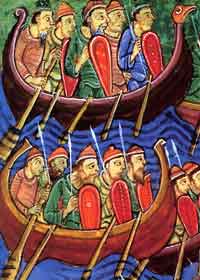 The Danish Invasion The Danish Invasion
Quick links on this page
Death of King Edmund 869
Partition- England/Danelaw 878
Saint moved to Bed'sworth 906
Mercia broken into Shires 920
Bury given to the monks 945
Abbo's Life of St Edmund 985
Battle of Maldon 991
Danes cause saint's move 1010
King Canute takes over 1016
Benedictines come to Bury 1020
Round stone church built 1032
W Suffolk given to Abbey 1044
Baldwin comes to Bury 1060
Foot of Page 1066
|
From the
Viking Invasion
to the
Norman Conquest
|
Pre 865
|
Please click here if you want to look back at the Early and Middle Saxon periods of our history. Now begins the Late Saxon era.
|
|
865
|
Modern historians refer to the 200 year period after 865 as The Late Anglo-Saxon time. This is because the year 865 heralded disaster for Anglo-Saxon England. It was the year of full scale invasion by the Great Army of the Danes.
The year began with a Danish army having over-wintered at Thanet. The men of Kent promised to pay them off, but the Viking host went inland and attacked the eastern part of Kent anyway. By the end of the summer, more vikings were to arrive in England, this time led by royal princes determined to do more than hit and run.
The Anglo Saxon Chronicle said that these Danes took winter quarters in East Anglia:
"And the same year a great raiding army came to the land of the English and took winter quarters in East Anglia and were provided with horses there, and they made peace with them".
According to Aethelweard writing 100 years later, the Danish leader was Igwar or Ivar, one of the sons of Ragnar Lothbrok. Ragnar Lothbrok or Lodbrok, (Leather Britches), was the most famous viking of his day. He had two sons involved in these first raids. One was called Ubba, and the other was known as Ivar the Boneless. "Boneless" probably refers to the snake, a creature thought to be full of cunning and fearless in battle.
This first attack may have taken place at Harwich, and the area around was possibly held by the Danish army for their winter stronghold, both for ships and men. The name Harwich itself could derive from Here Wic, or Army Port. If Dommoc was located, not at Dunwich, but at Walton Castle, it seems likely that this was the city or civitas first burnt down by the vikings in this attack as described by Abbo of Fleury.
The chronicle implies that King Edmund now paid them off in money, horses and supplies to keep the peace in East Anglia, and prevent further destruction.
Rather than return home with Edmund's payoff, as they had done in the past, the Danes stayed put and would proceed to move against other parts of Britain.
|
|
866
|
Having spent 865/866 in East Anglia, the viking force marched north from East Anglia, took York and thus conquered Northumbria. Meanwhile, their fleet sailed up the coast. The brilliant cultural life of the north, the schools, libraries, churches and minsters were all destroyed.
"An immense slaughter was made of the Northumbrians there".
|
|
867
|
After over-wintering at York, the Vikings moved on Nottingham and the Kingdom of Mercia.
|
|
868
|
Following Danish attacks in the midlands, the Mercians sued for surrender. The Danes went back to York for the winter, and now they would head back to East Anglia.
|
|
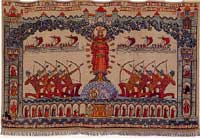
Death of Edmund
by Sybil Andrews
|
|
869
|
From York the Great Army of the Danes marched back into East Anglia, but this time they attacked Thetford. Thetford stood on the Icknield Way, at an important crossing point of the Rivers Little Ouse and Thet. The town could be reached not only by the army on horseback but, most importantly, their ships could reach Thetford by sailing into the Wash and then following the rivers through the Fens.
The Chronicle reads as if the Danes had already taken Thetford, intending to settle there for the Winter, when they were attacked by King Edmund, and his Anglo-Saxon fyrd, or army, in late November.
If King Edmund had indeed paid off the Danes to avoid war in 865, we do not know why the same thing was not attempted in 869. Perhaps the Danes now felt strong enough to take him on, or perhaps he had now resolved to resist them. He may have been given no choice, for as we have seen in Kent in 865, one band of Vikings would happily take your money, and then another band might attack you anyway.
"The Danish host rode across Mercia into East Anglia and took winter quarters in Thetford and in the same year King Edmund fought against them and the Danes had the victory. And they slew the king and overran the entire kingdom". That description came from the Anglo-Saxon Chronicle, version A, written between 877 and 899, and is the first record of the death of King Edmund, later to be called St Edmund, King and Martyr. A note to the Canterbury Version F of the Chronicles, adds that the Danish head men who slew the King were Ingware (Ivar the Boneless) and Ubba. Version E, copied at Peterborough in 1103 also added that they destroyed, or did for, (fordiden) all the monasteries to which they came, one of which was Peterborough itself.
" The Danish took the victory and killed the king and conquered all that land, and did for all the monasteries to which they came. At the same time they came to Medeshamstede (Peterborough) : burned and demolished, killed abbot and monks, and all that they found there, brought it about so that what was earlier very rich was as it were nothing."
Asser's 'Life of King Alfred' also recorded that King Edmund died in battle, as follows:
"In the year of our Lord's incarnation 870, which was the twenty- second of king Alfred's life, the above-named army of pagans, passed through Mercia into East-Anglia, and wintered at Thetford.
In the same year Edmund, king of the East-Angles, fought most fiercely against them; but, lamentable to say, the pagans triumphed, Edmund was slain in the battle, and the enemy reduced all that country to subjection."
The Danes also attacked Crowland Abbey in the Fens, and burned it down. Other monasteries assumed to have been destroyed around this time include Beodericsworth at Bury St Edmunds, Ely and Soham. Iken, Brandon and Burrow Hill were deserted, and may well have already been destroyed in the earliest attacks. Dommoc disappeared so completely that we are still debating its exact location.
This destruction of monasteries would be very significant because it implies a wholesale destruction of written records and literature in East Anglia, as well as the looting of the valuable trappings of the churches, together with their physical destruction. Steven Plunkett wrote that "The impact of the ninth-century Viking conquest of East Anglia was not superficial: in many ways it was cataclysmic."
|
|
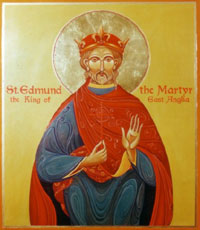
St Edmund |
|
blank |
Later stories were to tell how Edmund was captured in battle, and was offered his life to share his kingdom and renounce his Christian faith. This he refused to do and was shot with arrows and his head was cut off and thrown away. Within a generation Edmund would become accepted as a Christian saint. After the foundation of his abbey at Bury St Edmunds, for some five centuries Edmund was to become not only the patron-saint of East Anglia but also the patron-saint of all England. He is, of course remembered nationally to this day. This icon is a modern commission for the Orthodox Church of St John in Felixstowe.
The death of King Edmund is attributed to November 20th, and this remained his saint's day throughout the monastic period. The stories surrounding Edmund grew more detailed over time, and it is interesting to track the development of the legend.
The growth of the legend of St Edmund is described fully elsewhere in these pages, and can be seen by clicking here:
The Legend of St Edmund. According to Abbo of Fleury, writing in 985, the death of St Edmund occurred at Haegelisdun Wood. According to Herman of Bury, writing in 1095, the saint was then buried nearby at Sutton. Aeldorman Aethelweard, writing at the end of the 10th century said "and his body lies entombed in the place which is called Beadoriceswyrthe".
Some modern writers now support the ideas of Dr Stanley West that the location of Edmund's death was at Bradfield St George, rather than at Hoxne, which had been the claim of the medieval bishops after 1101. Dr West has noted that there still survives an old field name Hellesden, close to a Sutton Hall six miles south of Bury St Edmunds. Two miles north are Kingshall Farm, Kingshall Street and Kingshall Green. It seems likely that St Edmund's death would not have been far from his eventual resting place.
Up to this time there had been a single kingdom of East Anglia, consisting chiefly of today's Norfolk and Suffolk. Its land frontiers were defence works on the Icknield Way facing southwest and joining up two natural boundaries. The Devil's Dyke ran 7½ miles from Reach on the edge of the
marshy Fens to the dense forests still remaining at Stetchworth in the east.
The town of Thetford seems to have been attractive to these invaders as a base in East Anglia. They could bring their longboats up the Wash and follow rivers into the Little Ouse, and on to Thetford. Thetford also had ancient iron age earthworks which could be pressed into service as a camp and horse stockade. Thetford was certainly revived in importance from these beginnings as a Danish winter stronghold. For the next fifty years, East Anglia was under viking control.
The fate of the old monastic foundation at Beodericsworth, (Bury St Edmunds), is not known, and although the Chronicle says that they overran the whole kingdom, there does not seem to be any archaeological evidence yet found of any wholesale destruction by them.
At this time there were a few settlements scattered around Haverhill and we know nothing about their fate under the Vikings. These towns, including Sudbury, had prospered as border towns with Essex in the first decade of Edmund's reign, when East Anglia was at peace with Mercia and Wessex.
|
|
870
|
The Danes now moved against King Aethelred of Wessex and Alfred his brother. Battles took place at Englefield, ten miles west of Reading, at Reading itself and at Ashdown, Basing and Merton. The slaughter was great on both sides, enough to make Aethelwerd comment "that neither before nor after has such a slaughter been heard of since the race of Saxons won Britain in war". King Aethelred died after Easter and was succeeded by his brother, Alfred.
Ealdorman Aethelweard wrote his Chronicle towards the end of the 10th century.
|
|
871
|
King Alfred the Great became King of Wessex and the English until 899. He was a man of letters, so learning and history were important to him, but he was also a very practical man and a warrior. His chief pre-occupation was to ward off the Danish invasions and at first, things were at a very low ebb, and a very large payment of Danegeld was made to keep them out of Wessex.
|
|
873
|
The Danish host continued to harry the country. They now attacked Mercia, and finished off that Kingdom at the battle of Repton. The Danes then proceded to divide up Mercia, and reshape it as a Viking country.
|
|
875
|
With the increasing number of Danish attacks on the coast, the monastery at Lindisfarne was closed, and the monks moved to the mainland. They took with them treasures like the Lindisfarne Gospels, which were written in the period from 698 to 721. In 883 they settled at Chester Le Street, and in 995 they would finally move to Durham. Despite the assaults of Danish raiding parties the monks had saved some of their best books from destruction.
|
|
876
|
After 871, part of the Viking army settled at York and took to farming. Godrum led another part to Cambridge and in 876 they launched another assault on Wessex. They lost 5,000 men at sea, and were forced to retreat.
|
|
878
|
On the feast of Twelfthnight the Vikings surprised Alfred's army at Chippenham.
Much of Wessex was taken by the Danish and their territory was expanded to its greatest ever extent. Alfred even took refuge at Athelney in Somerset, later founding a monastery there in gratitude. By May, Alfred rallied the army and won a decisive battle over King Guthrum, or Godram, at Edington near the Bristol Channel.
The Peace of Wedmore was made following Alfred's victory at Edington, 15 miles from Chippenham. Under the Treaty the borders of Danish rule were rolled back and established east of Watling Street, along a line from London to Chester. Essex was ceded to the Danes.
The powerful kingdom of Mercia, which had dominated the country on and off for two centuries, was now divided down the middle. Mercia as a power was now finished. It would be Alfred and Wessex which would eventually rise to prominence henceforth. Godrum converted to Christianity and changed his name to Athelstan, his new Christian name. He also agreed to pull his army back into East Anglia. Various ranks of Danish and Saxon citizens and their values were set out in this Peace, and the country was now officially partitioned. The Danish held area was to become called the Danelaw.
As Athelstan, Godrum would start to issue coins in his new name, based upon the coinage of Alfred. For a viking, this was an adoption of English ways, as the traditional viking medium of exchange had always been hack-silver, for exchange by weight.
|
|
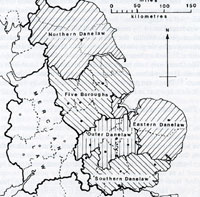
The Danelaw |
|
879
|
Danish settlement began in earnest following the peace treaty which had given them control over the North and East of England. Because Danish law was applied in these areas they were known as the Danelaw. East Anglia became the Eastern Danelaw, and the Anglo-Saxon Chronicle recorded the Danish settlement there:
"Here the raiding army went from Cirencester into East Anglia, and settled that land and divided it up".
In many ways the Danelaw, including East Anglia, now became like a Danish province. Old allegiances to local lords were weakened. Before the Danes, land could only be transferred by the King's charter. Viking law allowed it to be bought and sold in front of witnesses, at least in the chief towns of Cambridge, Thetford, Ipswich and Norwich. Streets like Colgate and Fishergate in Norwich took their names from the Danish 'gata', meaning street. York became a Viking capital, and its well known Coppergate derives from this time.
The Suffolk town of Beccles is particularly well endowed with 'gate' street names. These include Ballygate, Becclesgate, Blyburgate, Hungate, Ingate, Newgate, Northgate, Saltgate, Sheepgate and Smallgate.
The Hundred, hide, and virgate of the English south and west become the Wapentake, carucate and bovate of the Danelaw to the north and east. In East Anglia the only Scandinavian name to be widely adopted was apparently the carucate, as the word Hundred continued in use. The Hundreds of northern Britain, north of the Wash, all became called Wapentakes.
|
|
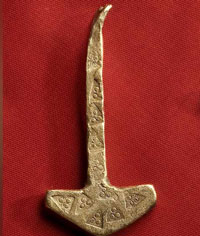
Thor's Hammer pendant |
|
blank |
This pendant of Thor's Hammer was a widely worn protective symbol by Viking invaders. It was found at South Lopham, but examples might be found all over areas where the Viking Army or Viking settlers may have camped. It is a typical "viking object".
'Viking' objects are increasingly found at Ipswich from this period through to the early 10th Century. Markets were known to exist at Ipswich, Bury St Edmunds and Dunwich. By 1086, the list was joined by Haverhill, Clare, Beccles, Blythburgh, Clare, Eye, Hoxne and Thorney at Stowmarket.
However, outside the townships the Danes do not seem to have had a great impact on East Anglian place names. Only in the areas of Flegg, Blofield and Lothingland in the Broadlands area are there any number of the characteristic Viking names like Hemsby and Filby, with the 'by' ending. More places seem to end in 'thorpe', however. Guthrum or Godrum, or Athelstan as he now was, seems to have settled into East Anglia, into the existing hundreds, with his followers, without it would seem, too much disruption. Perhaps they were quite like the Angles who were already there, and fitted in easily, or perhaps they liked the wooded river valleys where the existing people did not care to live. Guthrum had adopted Christianity and was regarded as King Alfred's godson, and no doubt this gave him some legitimacy with the English.
One imposition of Guthrum on East Anglia seems to be that the Bishoprics and their sees were abolished or set aside for next half century at least.
The administrative unit known as the "hundred" has an unknown origin. However, it is likely that it was brought into being by the Anglo Saxon kings. They survived through the period of Danish supremacy, even if they were renamed as Wapentakes, and seem to predate the later invention of the "shires". Later the hundreds would have their own courts, often held at a ford, or at a prominent hill or barrow, also known at the time as a hoe. Examples are the Thingoe and Thedwastre hundreds in West Suffolk. The seat of the Thingoe Hundred has been long considered to be in the area of today's Northgate Avenue in Bury.
|
|
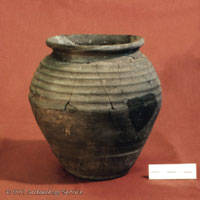 Ipswich Thetford-Type ware
Ipswich Thetford-Type ware |
|
880
|
Ipswich ware has been thought to have been produced from about 650 to 850. However, in The Ipswich Ware Project Paul Blinkhorn concluded that this range was more likely to be from 720 to 850. Nevertheless, by the mid to late 9th century, a new type of pottery was emerging which has been called Thetford Ware. On the website WWW.spoilheap.co.uk, by Sue Anderson, there is a is a good description and explanation, as follows:
"Thetford-type ware is so-called because kilns for the manufacture of this Late Saxon wheelmade pottery were first uncovered in Thetford. However, it is likely that the ware developed in Ipswich, where kilns have also been excavated, and was first made by Ipswich ware potters in the late 9th century. It is a medium sandy greyware, although fine and coarse fabrics are also known.
The main forms are plain jars with everted rims, but other forms included spouted bowls and pitchers, large strapped storage jars, handled jars and lamps.
This cooking pot is typical of the Ipswich variety of Thetford-type ware. It is in a relatively fine blue-grey sandy fabric and is girth-grooved. Other forms of decoration included bands of diamond rouletting (produced using a tool similar to a pastry wheel), applied thumbed strips, and occasionally incised wavy lines.
Thetford-type ware was produced in several areas. The main kilns were in urban centres such as Ipswich, Thetford and Norwich. It is possible that pots of this type were also being made in Sudbury and possibly Bury St. Edmunds. Rural production sites have been identified at Grimston and Langhale in Norfolk, but there were probably others."
Thetford type ware would continue to be produced into the mid 12th century.
|
|
880's
|
Despite the Peace of Wedmore, new Viking bands continued attacks on Wessex, although they also attacked continental Europe. The East Anglian Danes also used the Danelaw as a base from which to harry the west country.
They set up the five fortified boroughs of Leicester, Nottingham, Derby, Lincoln and Stamford to control and defend the Danelaw. York was the capital, well north of the treaty borders.
|
|
884
|
The Danes continued to harry Wessex at Rochester. The East Anglian Danes apparently joined in, and were attacked by Alfred. "And the same year King Alfred sent a raiding ship army into East Anglia. Immediately they came to the mouth of the Stour, then they met 16 ships of vikings and fought against them, and got at all the ships and killed the men".
|
|
885
|
By now the Danes under Guthrum had largely converted to Christianity, and within only twenty years of Edmund's death, they themselves were issueing coinage in his memory.
|
|
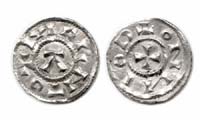
Memorial Penny from Thetford |
|
blank |
Viking coinage of Danish East Anglia was issued from 885 to 915. St Edmund memorial coinage was produced, as was coinage in memory of St Martin of Lincoln.
The coin shown here was found at Thetford in 2002. J North in his English Hammered Coinage describes this as possibly dating to the later period of Viking occupation of about 905 to 910, because the legend or lettering is "blundered", that is to say that it looks plausible, but makes no sense that we can discern today.
Another memorial coin, with a better legend in memory of Edmund, was copied for the 1907 Bury Pageant medallion. The moneyer was OTBERT, but the location of the mint is unknown.
It is entirely possible that the mint was in Thetford, a major town at this time. Possibly it was as big as, or bigger than, either Norwich or Ipswich in the late 9th Century.
Meanwhile Beodricsworth, the settlement to become Bury St Edmunds eventually, was probably a small community, possibly living on its memories of being a royal vill from the time of Sigbert, but now of no real importance.
|
|
886
|
"King Alfred occupied London fort and all the English race turned to him, except what was in captivity to Danish men".
|
|
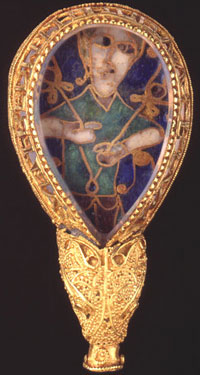 The Alfred Jewel
The Alfred Jewel |
|
890
|
The Dane Guthrum, who had converted to Christianity and settled with his band in East Anglia, died in 890, and was buried at Hadleigh. The Stour valley was, perhaps, where he had settled. He had a Christian burial, possibly at the ancient Aldham church.
By 890 King Alfred had held Mercia and Wessex and established a balance of power with the invaders. Alfred now found time to translate Latin texts into English and had these distributed to monasteries throughout his lands. One such text was "Pastoral Care" by Pope Gregory, which laid down the duties of priests to the people. To emphasise the importance of these texts and to encourage them to be read aloud to the monks, King Alfred would send out jewelled pointers or aestels along with the translations. This is believed to be the purpose of the so-called Alfred Jewel, illustrated here. An ivory or bone stylus was thought to be fixed to the bottom of the jewel, but is now lost. The inscription on it may be translated as "Alfred had me made".
None of these texts or artefacts would have penetrated into the Danelaw, where Christianity was becoming more acceptable to the Danes, but there were no functioning Bishoprics or monastic foundations as far as we know. It is generally thought that Sigeberht's monastery at Beodericsworth, or Bury St Edmunds, founded in 635, was defunct during these years.
Coins were minted naming Alfred King of the English, but of course, in practice, this excluded the Danelaw, north and east of a line from London to Chester.
|
|
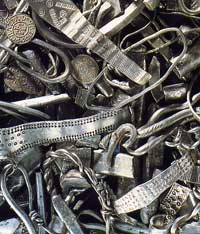 The Cuerdale Hoard
The Cuerdale Hoard |
|
892
|
Vikings landed in Devon and raided for more than a year. Alfred constructed burhs or defensive strongholds along his borders, following the Danish example. He also designed new ships meant for naval battles.
|
|
893
|
The Danes, including those from East Anglia, continued to attack in the west, at the Severn and north to Chester. The Welsh monk Asser wrote a "Life of King Alfred", in which he refers to the death of King Edmund in battle. John Asser became Bishop of Sherborne in the 890's, and worked for King Alfred in translating latin texts into English. Meanwhile the coinage known as St Edmunds memorial coinage continued to circulate in East Anglia as official Danish currency, testifying to the rapid acceptance of him as a Christian Martyr. His story was becoming more and more well known.
|
|
894
|
The Danes retreated to the East and fortified the area, but various battles continued on the borders of Wessex.
|
|
899
|
King Alfred died and was succeeded by his son Edward the Elder, who set about encroaching on the Danelaw himself.
By about 900 the Danes of East Anglia were becoming fully Christianised and more coinage was circulated which commemorated King Edmund. Perhaps the idea of honouring him as a saint was becoming universally accepted.
However, the Norse settlements in Scotland, Isle of Man and Ireland were now becoming a threat even to the Danelaw.
|
|
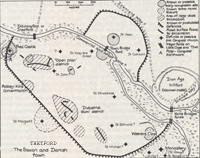 Danish and Saxon Thetford
Danish and Saxon Thetford |
|
904
|
The East Anglian Danes again started to raid into Mercia. King Edward retaliated and attacked between the Devils' Dyke and the Fens.
At some point around AD 900, a defensive ditch was erected to protect the fords at Thetford and the growing town. Much of the land enclosed by the ditch was still undeveloped farmland at the time. Alan Crosby's map shows the likely extent of the 20 foot wide ditch and bank enclosure. Crosby recorded that the ditch and bank remained visible up to the 18th century. A section remains today between Red Castle and the London Road. Please note that some features on this map, particularly churches and the monastery, date from well over a century later.
At this time Thetford was a town based around areas to the south of the Rivers Little Ouse and Thet. During the later Norman period the focus would switch to new developments north of these rivers.
|
|
905
|
The peace of Tiddingford was confirmed between King Edward the Elder and the Danes both with the East Anglians and the Northumbrians.
|
|
906
|
St Edmund's remains were moved to Bedericsworth from their original burial place in a small chapel at Sutton near to the site of his martyrdom. This must have happened with active Danish involvement and support. At Bedericsworth, (Bury St Edmunds) the wooden church of St Mary was enlarged and improved to hold the new shrine for St Edmund.
Back in the days of King Sigbert he had set up a small monastery there, but it seems unlikely that the monastery still remained from 630 as local lay volunteers had to guard the shrine. The acquisition of so notable a relic as a royal saint was to make the small town a place of pilgrimage and recipient of many royal grants for over 500 years.
Tradition was that one Oswen would open the tomb every Holy Week to cut the saint's hair and clip his nails.
|
|
910
|
The English and the Danes fought at Tettenhall.
|
|
912
|
King Edward the Elder, the son of Alfred the Great, took an army to Maldon in Essex and built a stronghold at Witham,
"and a good part of the people who were earlier under the control of the Danish men submitted to him". Fortifications were also built elsewhere, and it is possible that Bedericsworth was made into a fortified burh at this time, although this privilege is also attributed to King Cnut over a century later than this. Bungay and Sudbury may have been likewise fortified. At places like Thetford and Cambridge, where the Danes already had forts, Edward may have built his own burhs or forts to face them.
In Yates' Antiquities of 1805, he quotes various monastic papers as recording that Edward the Elder marched an army into East Anglia to repress the Danes. Having ravaged the country he retreated, but his Kentish men stayed behind at Bury, desirous of more plunder. They were then attacked by an alliance of Danes and the Saxon Ethelwald who wanted to contend for Edward's crown. In the battle, Ethelwald died, but the Kentish men were routed by the Danes.
The exact years in which this took place is open to doubt. One version of the Anglo - Saxon Chronicle gives 912 AD, but others read it as 920, but the most recent interpretation settles it at 917.
|
|
916
|
Edward the Elder set up several more fortified burhs, including Maldon in 916.
|
|
917
|
This was a turbulent year. Danish controlled Colchester was overcome by the army of Edward the Elder and many of its inhabitants killed. Edward was making it his mission to recover the Danelaw from the Danes, ignoring the peace treaty set up by his father, King Alfred the Great. Hundreds were killed in a siege at Maldon when the vikings fought back. King Edward the Elder then repaired and restored Colchester as part of the peace now agreed. The Danes decided to avoid a full scale invasion from Edward and his Wessex men. The chronicles say that many people submitted to him from both East Anglia and Essex which had been under Danish rule. The Danish controlled force from Cambridge also accepted Edward as Lord and Protector.
This peace treaty is interesting in that the Danes of East Anglia do not agree to surrender. They agree to "annesse", or oneness. A union of the two peoples is agreed. This allows East Anglian Danes to retain their lands and their laws, whereas the Cambridge and Essex Danes have to submit. Bedfordshire and Hertfordshire had already capitulated in 912.
Because of this peace treaty, it has been suggested that the Shires of Norfolk and Suffolk were imposed on East Anglia at this time. However, Dr Lucy Marten argues that this did not happen at this time, because of the particular type of treaty agreed. She argues that East Anglia continued as one entity until the time of King Cnut. Peter Warner in "The Origins of Suffolk", also argues that the county boundaries did not exist at this time, but he suggested that they did not come into being until the time of the Norman Conquest.
Please note that the date of this attack by Edward the Elder has been unclear to many writers, and it has been described as happening earlier, in 912, or even as late as 920. Nevertheless, by this time Edward seems to have broken up Mercia, his rival kingdom, into shires such as Cambridgeshire, Warwickshire and Staffordshire to weaken it as one unit. A Reeve or Sheriff was set up over each shire. Because of the arrangement now agreed, it seems that East Anglia was not similarly broken into Norfolk and Suffolk at this time.
Edward has been said to have set up the system of hundreds, as sub divisions of the shires, for the purposes of administration and taxation. However, it is more probable that these were older, dating from the days of Anglo Saxon control, and that the Mercian shires were made by grouping hundreds together. No doubt, where it suited Edward for political reasons, he would carve up the existing hundreds to make his shires along new boundaries which he specified.
|
|
920
|
By 920 the viking coinage seems to abruptly disappear from the East Anglian scene. A hoard of coins deposited at Brantham in about 920
contained only coins of Edward the Elder. There were no St Edmund memorial pennies, and no viking coins at all. This seems to indicate that Edward had held a massive re-coinage which resulted in all earlier coins being exchanged at his mints to be melted down and re-issued in his name. They were also issued at the new higher weight standard which had hitherto not been adopted within the Eastern Danelaw.
This reflects the fact that East Anglia agreed to "oneness" with Edward the Elder, and the Scandinavians gave up the right to produce their own locally designed coins.
|
|
923
|
York was taken by the Norsemen under Raegnald and held by Norse Kings until Eric Bloodaxe was killed in 954.
|
|
924
|
Despite Norse success at York, by the end of his reign Edward the Elder had pushed the Danes northward into Northumbria. When Edward the Elder died in 924, he was succeeded by Aethelstan who quickly took over Northumbria and Cornwall.
|
|
925
|
According to Yates' Antiquities, monastic papers recorded that in 925 the ecclesistical votaries of St Edmund were incorporated into a college of Priests, either by King Aethelstan, or by Bederic, under royal protection. Bederic was, or had been, the local chief lord, and he or his descendants may have supported the new shrine by giving it land for the clergy to live off. This story is merely reporting a more formal arrangement being put in place to maintain the shrine of St Edmund.
|
|
927
|
King Aethelstan invaded Northumbria and took York, expelling the vikings, including kinsmen of Anlaf Guthfrithson, the king of Ireland.
|
|
932
|
The kings of Wessex tended to rule their dominions by way of Eldermen, or Ealdormen. From 932 East Anglia was run by Elderman Athelstan, who became so respected and powerful in East Anglia that he gained the popular name of Athelstan Half-King. Perhaps this helped to distinguish him from Aethelstan, King of Wessex.
This title supports the view of Dr Lucy Marten that East Anglia was still un-shired at this time. The old kingdom of East Anglia was still in one piece, and so Athelstan ruled the old kingdom, but perhaps because he owed allegiance to King Athelstan of Wessex, he was known as half-king.
|
|
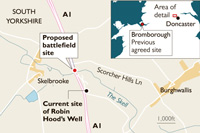
New site of Brunnanburh
|
|
937
|
In retaliation for Aethelstan's capture of Northumbria and York in 927, the Irish King Anlaf Guthfrithson, Owen king of Strathclyde and King Constantine of Scotland joined forces to invade England in the summer of 937, with a massive fleet of ships. Aethelstan advanced out of Mercia to meet the invasion, and this occurred at the Battle of Brunnanburh.
The chronicles merely report that King Aethelstan won a major victory at Brunnanburh and the Northmen's lord was put to flight back to Dublin. This battle remains rather obscure to us today. We do not know where it took place but it is thought to have been the bloodiest and most important battle on British soil until the Battle of Hastings in 1066. The poem Battle of Brunanburh recounted that there were "never yet as many people killed before this with sword's edge ... since from the east Angles and Saxons came up over the broad sea".
The anglo-saxons under King Aethelstan, grandson of Alfred the Great, had to fight the combined forces of Vikings, Scots and Northumbrians. Had Aethelstan lost the battle it could have meant the end of Anglo-Saxon England.
More than 30 places have been suggested as the site of Brunanburgh, one of the most popular being at Bromborough on the Wirral at Merseyside. Professor Michael Wood suggested in 2017 that it was far more likely to have been fought along today's A1, always the main route from Viking York to Mercia, Wessex and the English heartlands. He prefers a site at Robin Hood's well, near Burgh Wallis, a village seven miles north of Doncaster.
|
|
940
|
King Edmund (NB not our St Edmund) succeeded Athelstan and continued the war with the Danes. Edmund was grandson of King Alfred the Great and ruled Wessex from 939 to 946. Because he was named after St Edmund he took a great interest in his shrine at Bedericsworth.
Edmund was also interested in the church in general and wanted to help the monasteries in any way he could.
|
|
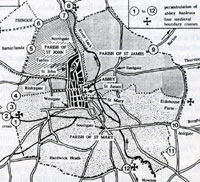
Banleuca Boundaries by C R Hart
|
|
945
|
According to an Anglo-Saxon Charter, in 945 King Edmund gave up his royal rights to taxes and all feudal dues and fees in the area of Bury St Edmunds for about one mile around St Edmund's shrine. M. D. Lobel was not the first writer to consider that this charter was spurious, invented by the monks at a later date to bolster their claims. Their reason for doing this would be that this was the first charter to grant many of the privileges claimed by the monastery. As such, its existence needed to be established, because later grants and charters tended to confirm existing rights, while in some cases, extending them.
There is no original of this document as it had been replaced by fresh versions. In later years it was normal practice for well worn and faded old records to be copied in the monastic scriptoria for everday use. So we have only a few of these later copies to consult, and they are not all consistent.
Since Lobel's day there has been much research into these early charters, and in 1968 P H Sawyer produced a catalogue called "Anglo-Saxon Charters: an Annotated List and Bibliography". This replaced earlier lists by J M Kemble, published in 1839-1848, and W Birch in 1885 to 1893. This charter of 945 is now catalogued as S 507, and further details can be seen by clicking on that reference.
Dr Cyril Hart largely accepted the authenticity of this charter and other recent research has described the content of this charter as "worthy of favourable reconsideration."
|
|
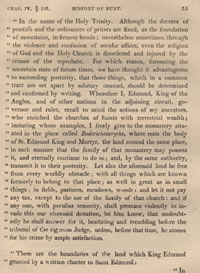
The charter exemptions by Yates |
|
blank |
Cyril Hart summarised the charter as, "a statement that the land surrounding the monastery is to be free of all tribute, such payment being rendered solely to the monastery. This appears to represent exemption from the three common dues - a rare privilege - together with exemption from from the payment of taxes into the royal fisc; when a national tax is levied (based on the hidage) the inhabitants are to pay their levy to the monastery, and not to the king."
In 1805, the Reverend Richard Yates provided his own translation of this charter, which may be read by clicking on the thumbnail shown adjacent to this paragraph. According to Yates, the monks stated that this was their first charter, and that, "This has the priority of all our charters." This translation does not refer solely to the freedom from taxation, but actually appears to include a gift of the land itself. If so, we must assume that the land was in the king's ownership to enable such a gift to be made. Yates's translation for this section is as follows:
".....I freely give to the monastery situated in the place called Bedericheswyrthe, where rests the body of St Edmund, King and Martyr, the land around the same place, in such a manner that the family of that monastery may possess it and eternally continue to do so; and, by the same authority, transmit it to their posterity......free from every worldly obstacle......and let it not pay any tax except to the use of the family of that church......"
Exactly what happened to Bederic's own rights as the local lord, at this time is not known. Although the documents do not seem to imply that he, (or his rightful successors), lost any of their old rights in 945, perhaps he had already lost his lands. Thus Bederic may, or may not, have continued to receive his own local dues. These may have included Landmol, a rent on farmland in the town fields, which lay outside the town boundary. Jocelin tells us that by his time, from every acre of the nine hundred that had been Bederic's, the payment was two pence. By the time of Jocelin of Brackland, in the late 12th century, this rent was collected by the reeve and paid to the sacrist.
Bederic himself was either paying some of this cash over to the Earl, who had the rights in East Anglia, or he was providing other duties and fees to him as landlord in chief. We do not know how the old Saxon system of dues had been altered by Viking rule.
Jocelin also believed that, "when the town was made free, [presumably 945] the service owed for these lands was divided into two, in such a way that the sacrist or the reeve took a levy at the rate of 2d per acre, and the cellarer had ploughing and other services." In fact, we must treat this assertion with caution, as it is doubtful whether these posts existed at this time in this pre-Benedictine community. However, Jocelin was sure that this arrangement was very old.
Jocelin also reported that by his time, (c1198) the Cellarer of the Abbey held a messuage and barns near Scurun's Well, "which had been the manor house of Beodric, lord of this town in ancient days, after whom the town used to be called Beodricsworth. His fields are now in the demesne of the cellarer, and what is now called averland was the land of his peasants. The total estate which was held by him and his men consisted of 900 acres, and these lands are still the town fields." According to Antonia Gransden the cellarer's manor was known as the grange of St Edmund, or Eastgate Barns. The Scurun's Well messuage and barns therefore seems to be identified with Eastgate Barns, sometimes referred to as Holderness barns along Holderness Lane, off Eastgate Street. On the OS map for 1955 it is named as Grange Farm.
Moving on now to the area which was included within this grant of privileges, this was described within the otherwise latin charter as a perambulation in Old English, which reinforced Hart's view that this part was, indeed, genuine.
The part of the charter which deals with the boundaries of the granted area is very confusing to modern eyes. We cannot recognise many of the landmarks. In S 507 the text goes as follows:
"This sindon tha land gemere the Eadmund king gebocade in to sancte Eadmunde . thonne is thær ærest suth be eahta treowen . 7 thonne up be Alhmundes treowen . 7 swa forth to Osulfes lea . 7 swa forth on gerihte be manige hyllan . 7 thonnen up Hamarlunda . 7 swa forth æfter than we se Lytlantune . 7 thonen ofer tha ea æfter than wege to Bertenedene . 7 swa on gerichte east to Holegate . 7 swa forth an furlang be easten Bromleage 7 thonan suth to niwantune meaduwe."
This list of landmarks may be translated as follows:
- First south by the Eight Trees
- Then up by Ahlmunds trees
- So forth to Osulf's meadow
- So forth on the right by many hills
- Then up Hamarlunde
- To four mounds (hogas-after Hart and not in S507 version)
- So forth after we see Little Town
- Then over the running water
- After then the Way to Berten or Barton Valley
- So on right east to Hole Gate
- So forth one furlong by Eastern Bromleage
- Then south to Nowton Meadow
Dr Cyril Hart has produced the attached map which plots his interpretations of these landmarks. Such a boundary description is known as a "perambulation", and was the normal method of describing a location at this time. Oliver Rackham has pointed out how often major trees or woodlands were regarded as permanent landmarks in these perambulations. Incidentally Dr Hart has also pointed out that this charter contains the earliest known reference to a unit of length called a furlong. A furlong was later fixed as 220 yards, or about 201 metres, but how precisely this distance was measured or understood at the time is unclear. Later there would be 8 furlongs to a mile. The word was said to derive from the words Furrow Long.
|
|

The charter town boundaries in Yates |
|
blank |
In Richard Yates "Antiquities of Bury Abbey" of 1805, Yates gives a different latin text, and provides his own English translation, which is shown here. However, once again, there is an inconsistency over dates. In the monastic copy of the decree cited by Yates, and pointed out by him, the date of the copy charter he saw was referred to as 945 at its start, and 942 at its end. The ending of the copy denoted as Sawyer S507 gives the date as 945, as follows:
"Acta est hæc præfata donatio anno ab incarnatione domini nostri Jhesu Christi . DCCCC . XLV . Indictione . III . "
The record states that King Edmund gave these rights to the collegiate church (also called the convent) of St Edmund. It would appear that by now, the lay volunteers who had first tended the shrine since 906, had been incorporated into a college, or body, of priests. King Edmund was the son of Edward the Elder and granted the lands round Beodricsworth to the 'Familie monasterii,' or family of the monastery, as it is termed in one charter quoted by Arnold in Memorials of the Abbey of St Edmund. (See charter S 507,). At that time the household or college of clerks, to whom the duty of guarding the shrine was assigned, consisted of six persons, four priests and two deacons, according to Herman in 1095. They probably also supported their wives and families.
This area of land was later to become known as the Banleuca and its grant indicates the important status of the shrine of St Edmund and the growing importance of its monastery. The income from the Banleuca belonged, therefore, to the college of priests as a whole, and did not belong to the Abbot alone when in later years, this was to become an issue. Most of this area was farmland at this time, with only small settlements around the farms, and Bedericsworth was just a growing village around the shrine. In later years the boundaries of the banleuca were to be marked by four stone crosses on the main roads into town. The map shown here displays the banleuca and parish boundaries by the 1990's, overlaid on features that would have existed in the 15th century, but are now gone. This grant of land by King Edmund effectively defined the administrative boundaries of Bury St Edmunds right up until 1934 when parts of Westley and Fornham were added to the town to the north west. This additional land is also outlined on this map.
One significant factor in this story may be that it was in 945 that King Edmund married the Lady Aethelflaed of Damerham. Damerham is in Wiltshire, but Aethelflaed was the daughter of Aelfgar, who had just become the Ealdorman of Essex. Aelfgar held estates in Essex, but also had lands in the county that we know today as Suffolk. In 945, however, this name did not exist. It was part of East Anglia. Nevertheless, suddenly the King has now got a family interest in some land in East Anglia, and perhaps prompted by Aethelflaed, he made this gift to St Edmund. It was not a large area by the standards of royal monastic endowments of the period, but maybe that was all there was to give, and maybe the shrine had few needs at the time. This was a small part of the slow integration of East Anglia into the control of the Kings of Wessex and England.
Another significant factor surrounding this arrangement is the effect it must have had upon other local taxation arrangements. By 1086 we know that Sudbury was added to the Hundred of Thingoe. It seems likely that this would have taken place to compensate Thingoe Hundred for the loss of the tax revenues from the Banleuca of Bury, and thus it is likely to have been undertaken at the same time that Bury was exempted from the tax. This puts the arrangement in 945, and also leaves us with the conclusion that the Hundredal system itself was established by this time. If we accept that East Anglia was not divided into Norfolk and Suffolk until the time of Canute, c. 1021, then it follows that the Hundredal system pre-dates the introduction of Shire Counties.
Not only did King Edmund give the monastery a permanent independent income from the Banleuca, he was also said to have given it the manor of Fornham Parva, its first landed property outside the town precincts. Fornham Parva is considered by Dr Hart to be the "Little town", of the charter perambulation, and is now called Fornham St Martin.
|
|
946
|
Eadred became King of Wessex following Edmund's death. There were no Bishops of East Anglia at this time, but it appears that the Bishop of London had a manor at Hoxne, from which he may have exercised some degree of church authority. Bishop Theodred seems to have been Bishop of London around 938 to 941.
|
|
947
|
During the 940's the area around Rendlesham, from the River Orwell to the Alde, was administered as one province by a Danish earl. The area was then known as the Wick Law, or Wicklaw, or Uicchelaue, but was probably an old administrative unit dating back to Raedwald and the Wuffing Kings of the early 7th century. Its base was at Sudbourne, near Iken, at this time.
|
|
948
|
In the period from 946 to 951, Aelfgar, the Ealdorman of Essex, made his will. This will is catalogued by Professor Sawyer as S 1483.
Aelfgar not only held estates in Essex, but much land in today's Suffolk, south and west of Bury.
It is interesting to see from this will, that the right to make a will was not easily available to everybody. Aelfgar, despite his position, had to earn the right to make his will, as follows:
"And Bishop Theodred and the Ealdorman Eadric told me, when I gave to my lord the sword which King Edmund gave to me, which was worth a hundred and twenty mancuses of gold and had four pounds of silver on the sheath, that I might have the right to make my will; and God is my witness that I have never done wrong against my lord that I may not have this right."
Aelfgar seems to have become an Ealdorman around 944, and his daughter Aethelflaed became the second wife of King Edmund in or about the same year. By this time she was, of course,a widow, King Edmund having died in 946. In his will, Aelfgar left his estates at Cockfield, Ditton and Lavenham to Aethelflaed. However, after her death, he willed that Cockfield should go to St Edmund's foundation at Bedericesworth, and Ditton should pass to "whatever holy foundation seems to her most advisable."
The sentence in Old English referring to Bedericesworth is as follows:
"And þanne ouer vre aldre day ic an þat lond at Cokefeld into Beodricheswrthe to seynt Eadmundes stowe."
Aethelflaed had a sister called Aelfflaed, and in the years between 1000 and 1002, she also left an estate at Cockfield to St Edmund's. It is not clear if this is the same land or another parcel of land at Cockfield. If it is the same land, then it shows that Aelfgar's will was slightly amended in later years to allow both sisters the benefit of the income before it passed into the hands of the monastery of St Edmund.
Aelfgar's will also said the should Aethelflaed produce a son, then he would inherit Lavenham after her death. If not, Lavenham would pass to a religious house at Stoke, presumably Stoke by Nayland. Stoke was also to inherit woodland at Ashfield from Aelfgar.
Aelfgar's connection with Stoke by Nayland is explained in Aelfflaed's later will. She asks in her will, Reference S 1486 of 1000 x 1002, that "my Lord protect the holy foundation at Stoke, in which my ancestors lay buried."
Another local bequest in Aelfgar's will was of the estate at Rushbrooke which he left to his mother, and on her death to one Winehelm.
|
|
951
|
In the period between 942 and 951, Bishop Theodred of London made his will. This is recorded as reference S 1526 in the Sawyer catalogue of Anglo-Saxon charters. He left a number of bequests of land to his family and to various churches, including St Paul's in London.
One bequest was "land at Horham, Athelington, (Suffolk), to St Æthelberht's church at Hoxne". Hoxne was the Bishop's episcopal demesne, or official church seat, and the church there was still dedicated to St Aethelbert. It was not until the 11th century that the dedication was changed to St Edmund, perhaps indicating that Edmund was not thought to be connected to Hoxne at this time.
Another bequest of importance to the monastery at Bury was as follows: "land at Nowton, Horningsheath, Ickworth and Whepstead, to St Edmund's church." Theodred does not need to mention the location of St Edmund's church, but records that the bequest is for the sake of Bishop Theodred's soul.
Another bequest of local land was "land at Barton, Rougham, Pakenham, Suffolk, to his kinsman Osgot, Eadulf's son".
This charter of 942 to 951 is catalogued as S 1526, and the Old English text and other details can be seen by clicking on that reference.
|
|
952
|
King Eadred commanded "that many should be put to death" in Thetford in vengeance for the death of the Abbot there. This was Abbot Eadholm of Canterbury, and why he was in Thetford and why he was killed, we do not know. However, East Anglia did not have its own local bishoprics during this period of Danish rule, and neither did King Eadred seem to have any lands in the area. In his will, Eadred would leave money to Mercia to protect themselves from the Danes, but left nothing to East Anglia, which was much more in the front line than Mercia. So Eadred did not wield the same power and authority in East Anglia as he did elswhere. Perhaps he had sent Abbot Eadholm to establish a new minster under royal control, or to collect taxes for him. Eadholm met deadly resistance, whatever his mission, and the King had to take bloody revenge.
|
|
954
|
The end of Scandinavian domination in Northumbria came when Eadred, King of Wessex defeated Eric Bloodaxe at York in 954. In the 25 years peace that followed there was a cultural and religious revival.
During the 950's it has been written that the Bishop of London inspected the body of St Edmund in his shrine and confirmed that it was incorrupt, and only a thin red crease, like a piece of thread, showed where the head had been severed. Presumably this would have taken place before East Anglia had its own Bishop again.
|
|
955
|
Between 952 and 956 King Eadred set up the new diocese of North Elmham to serve Norfolk and Suffolk. The dioceses of South Elmham and Dommoc had been set up in about 680, but had been defunct since 872, through the period of the Danelaw. So from 955 East Anglia once again had its own Bishop and church hierarchy. The new Bishopric of Elmham covered the areas of the original two dioceses.
The names of the first Bishops of North Elmham have been listed in Wikipaedia as Athulf, (955-962), Alfrid, (962-967) and Theodred II, (967-973).
By the end of 955 King Eadred was dead, and was succeeded by King Eadwig, or Eadwy.
|
|
956
|
The newly crowned English King, Edwy, is recorded as having given the manors of Beccles and Elmswell to the monastery of St Edmund. Registers such as that of Walter de Pynchbeck also state that many of the undocumented possessions of the collegiate church of St Edmund were given in this same period of 952 to 956. The lack of charters and grants from these days was attributed to the confusion of the eviction of the secular priests and their replacement by Benedictines, which would take place in 1020.
Norwich and Thetford had both flourished in this century, expanding beyond their old fortified limits.
|
|
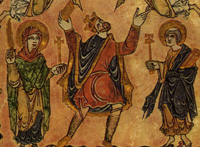
King Edgar's religious reforms
|
|
959
|
Edgar became King of England, following the death of Eadwig or Eadwy, and appointed Dunstan as Archbishop of Canterbury in 961. Dunstan, with St Aetholwold and St Oswald, embarked on a programme of Church expansion and reform based on the new French ideas of monastic life. Dunstan was already committed to the Benedictine way of monastic life, and he would proceed to promote it with Edgar's full approval. The illustration is dated 966, when the New Minster at Winchester was given its reformed Benedictine Charter. The painting represents the brand new Winchester style of illustration.
When Edgar became sole king of England a uniform coinage was instituted throughout the country. A royal portrait was on one side. The reverse had a cross with the name of the mint as well as the moneyer. Under Eadgar most fortified towns of burghal status were allowed a mint. The number of moneyers depended on the size of the town. Thetford was certainly one of those towns allowed to produce coinage. Many of the coins of King Edgar do not include a mint mark. J J North recorded an uncertain mint mark of "THI", which he tentatively attributed to Thetford, with a moneyer called Aelferd.
Bury St Edmunds does not seem to have qualified to have a mint at this time, reflecting its comparative lack of importance as a commercial centre at this time.
King Edgar also recognised some of the old Danish liberties by now well established in East Anglia. This contrasted with the status of Englishmen who were still subject to the king's laws. The relative freedoms thus retained by the Anglo-Danish East Anglians helped to stimulate economic activity and wealth in the region. Some people hated Edgar for this tolerance of 'evil foreign customs'.
Thus, despite East Anglia having nominally been "re-conquered " by the Kings of Wessex, who were now Kings of England, East Anglia remained one unit, not yet divided into Norfolk and Suffolk. Its local government was still run by Aethelstan Half King, and the Witan or council of the richest and noblest local aristocracy.
|
|
960
|
Around this time Aethelstan withdrew to become a monk at Glastonbury. His son Aethelwald now became Ealdorman of East Anglia until 962.
|
|
962
|
In 962 Ealdorman Aethelwald of East Anglia, and son of Aethelstan Half King, died. According to William of Malmsbury, he was killed by King Edgar, in revenge for a deception involving a woman. Aethelwald's brother Aethelwine now became the Ealdorman of East Anglia, a post he would hold until 992.
King Edgar drew up his will, (Sawyer reference S 703), and left 7 hides of land at Chelsworth to Aethelflaed of Damerham. She had been the second wife of King Edmund, and thus was stepmother to Edgar. This land seems to have later passed into the hands of Aethelflaed's sister, Aelfflaed, because Aelfflaed would in turn leave it in her will, dated between 1000 and 1002, to the holy foundation of St Edmund.
These wills are difficult to date, because they are drawn up sometimes well before the author's death, and can only be dated by the witness list attached to them. These lists were drawn up in strict order of precedence, with the most important names at the head of the list. These wills do not actually take effect until the author dies, and this date is often also unclear.
Thus we have the will of Theodred, which follows, drawn up probably before this date, but not put into effect until his demise around this year. This event was recorded by Yates, in his Antiquities of the Abbey, published in 1805.
Theodred the second, the Bishop of Hulm, (which we call Elmham), and London, left to St Edmund's the manors of Nowton, Ickworth, Whepsted, Horringer, and 'other valuable manors in the vicinity of Bury'.
Bishop Theodred also left lands to other monastic foundations. He gave land at Horham and Athelington to St Aethelbert's church at Hoxne for God's Brethren to benefit. We may note at this point that there is no suggestion of any link between St Edmund and Hoxne at this time. St Aethelbert's church at Hoxne would not be re-designated to St Edmund until about 1102.
|
|
966
|
Adulphus, or Athulf, became Bishop of Hulme, (Elmham) after Theodred, and he also bequeathed valuable properties to St Edmund. In his case it was said to be nine manors, the biggest gift so far. Yates also reported that monastic papers claimed that around this time the monastery also received Cockfield and Chelsworth from Ethelfled's will, the daughter of Earl Alfgar. The King's Chancellor Turketell, gave it Culford, part of Palgrave, and other possessions.
|
|
969
|
Ramsey Abbey in Huntingdonshire was founded by Archbishop Oswald, under the lay patronage of Ealdorman Aethelwine of East Anglia. The Ealdorman was responsible for most of its initial endowments from his own possessions. The importance of Ramsey for St Edmundsbury is that the first Life of St Edmund would be written there in 985. That fact is undisputed, but more uncertain is the relationship between Ramsey and the monastic foundation at Bedericsworth. Both Antonia Gransden and Cyril Hart suggest that the clerks at St Edmunds were now placed under the spiritual direction of Ramsey Abbey. Hart also suggests that any such control was extinguished in 1016 at the Battle of Assendun, where Ramsey monks were present on the 'losing' side, and King Cnut then personally took St Edmunds under his wing.
Ramsey was located within Mercia, an area much more amenable to central control than the independent East Anglia, and this period of suggested "control" by Ramsey must still be open to some doubt. Although Aethelwine was Ealdorman of East Anglia, his home was at Upwood, close by Ramsey, and it seems that he also did not get very much involved with issues inside East Anglia.
|
|
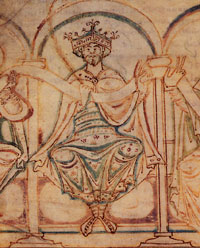
King Edgar and Regularis Concordia |
|
970
|
A new set of regulations for monastic life in England, based on Benedictine practice was drawn up by Ethelwold, (later St Ethelwold), the Bishop of Winchester, with the close approval of Dunstan, (later St Dunstan), the Archbishop of Canterbury. It was known as the Regularis Concordia. The Regularis Concordia, organised by King Edgar as an agreement between the king and the monks and nuns of England, required that they simplify their lives, and follow the sixth-century Monastic Rule of St. Benedict from Italy. In return, the monks were under the special care of the king, and nuns under the care of the queen. In addition, the monks and nuns of England, as those who lived the most saintly monastic lives, were required to offer prayers for the King and Queen.
These new rules led to such a well trained body of monks that monastic life remained strong throughout the Danish invasion and up to the Normans.
King Edgar actively supported and enforced all these church reforms, removing secular monks and replacing them by celibate monks with allegiance to St Benedict's rule, rather than to local landlords.
These church reforms were supported by Ealdorman Athelstan, 'Half-King' of East Anglia, who helped refound the monastic houses of Peterborough, Thorney and Ely. These houses had been ruined by the Danish invasions, and at Ramsey, a great new religious house was set up. Although nowadays we would regard these Fenland towns as part of East Anglia, in 970 they were part of Mercia. However, St Etheldreda of Ely had been a Wuffing Princess, and the area around Rendlesham had been a Wuffing royal estate since the days of King Raedwald, who died in 625. Whatever the reason, King Edgar was able to issue a charter to give Ely Abbey the rights to the Wicklaw or Wicklow, an area of five and a half hundreds in East Suffolk around Rendlesham and Woodbridge. Ely soon let them to a tenant in order to get land closer to home.
Despite the fact that the King was pushing Benedictines into minsters across the country, he did not seem to have the lands or the authority to push them into East Anglia, and in particular, into Beodericsworth, or Bury St Edmunds, as we now know it.
The clergy who were in control of St Edmund's shrine may have had wives, and did not follow the new fangled Benedictine strict codes of subjugation to the rule of a monastic order. They were only a small community and would not have been able to resist the King's will unless East Anglia was indeed still a self governing unit, only partially at one with the rest of the country.
Hundreds were first mentioned in the Laws of Edgar in 970, and by the time of Ethelred the term referred to an area of one hundred hides for the purpose of taxation. It has been suggested that originally a hundred could support 100 men, and that some, if not all, of the hundreds dated back to pre-Viking times.
Curiously, most authors say that the Danes have left only a handful of Parish names in Suffolk and five have been identified as Risby, Lound, Ashby, Barnby and Eyke.
|
|
971
|
In the year 653, St Botolph had founded a minster at Iken, (Icanhoe), in Suffolk, on the banks of the River Alde. When he died in 680, he was buried there. With his new foundations being put in place in Mercia, it seems that King Edgar wanted to support them by allocating some of the remains or relics of St Botolph to the new minsters at Ely and Thorney. He gave permission for the saint's remains to be moved. For some reason the removal got as far as Burgh, near Grundisburgh, and there they lay for another 50 years until the time of King Canute.
|
|
973
|
Dunstan, the Archbishop of Canterbury, seems to have delayed Edgar's coronation for 13 years, until the king was 30, the age for ordination of priests. However, it is likely that he was crowned in 959, when he came to the throne, but that the 973 ceremony was to be a new, more religious occasion. The kingship ceremony was made intensely religious at this time, and the King became Christs' appointed, a religious power as well as a secular one.
|
|
975
|
King Edgar the Peacable had sons by two different wives. The oldest son by his first wife was called Edward. His son by his second wife was called Aethelred. In 975 King Edgar died to be succeeded by his young son Edward, who would eventually become known as Edward the Martyr.
King Edgar's will had left 7 hides of land at Chelsworth to Aethelflaed of Damerham. She had been the second wife of King Edmund, and thus was stepmother to Edgar. Aethelflaed herself made a will between 962 and 991, but probably after 975. This will survives as Sawyer Reference S 1494.
Many of her lands were left to her sister for life, and then to a religious institution after her sister's death. These lands included the following clauses which benefitted the monastery at Bury St Edmunds:
" And I grant the two estates, Cockfield and Chelsworth, to the Ealdorman Brihtnoth and my sister for her life; and after her death to St Edmund's foundation at Bedericesworth."
"And I grant the estate at Elmsett to the Ealdorman Brihtnoth and my sister for their lifetime, and after their death I grant it to Edmund."
These lands subsequently passed into the hands of Aethelflaed's sister, Aelfflaed, anf Aelfflaed would in turn leave them in her will, dated between 1000 and 1002, to the holy foundation of St Edmund.
|
|
978
|
The young King Edward was murdered, probably as a result of the feud between the factions supporting the families of each of the wives. Aethelred was placed on the throne, and memories of the bad circumstances around his accession would dog his career. He himself was only a boy of 9 or 10 when he was made King. The country was incensed by the intrigue and many were ready to fight his rule. Aethelred II would rule from 978 to 1016, a period afflicted by constant Danish attacks on the country. After his reign he became known as Aethelred the Unready, but the Old English word "unraed" is believed to have been best translated as 'ill-advised'.
Many types of coinage were issued over the period of his long rule, but moneyers at Thetford issued examples of all these types, as did Ipswich and Norwich. Fewer types were issued at Cambridge. Bury St Edmunds was too unimportant to be ranked as a minting borough at this time. Bury's first coins would not appear until 1048.
Meanwhile King Harold Bluetooth was uniting Norway and Denmark and imposing Christianity by force, building up a strong autocratic state.
|
|
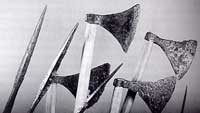
Viking Axes from London |
|
980
|
The Vikings raided the coasts and sacked London. It is possible that these raiders were pagans who were driven out of their homes by Harold Bluetooth and his violent imposition of Christianity.
The period from 800 to 1300 has been called the Medieval Warm period, and in 980 Erik the Red was forced into exile from Norway. Because the climate was improving, he was able to explore northwards, and to establish a settlement in Greenland which lasted until about 1500.
|
|
981
|
The Anglo Saxon Chronicle recorded attacks by pirate hosts from the north on Southampton, Thanet and Cheshire. Although there is no mention of attacks on East Anglia, Dr Lucy Marten has suggested that these almost certainly did take place each year after 980. The east coast was readily accessible to the Danes, and news from East Anglia was not usually reported in the Chronicles written far away in Wessex.
|
|
983
|
Ealdorman Aethelwine of East Anglia had been charge in those lands since 962. By 983 he had risen in status to become the chief Ealdorman in the land. His name would now be at the head of those witness lists that attested to all major wills and Charters. His home was at Upwood near Ramsey, and he was a major patron of Ramsey Abbey, and was regarded as "Amicus Dei", by the monks at Ely, or a Friend of God. Thus, although he was Ealdorman of East Anglia, he lived outside those lands, and his home was in a part of Mercia.
Although he held estates in Wangford Hundred, and had leased the Wicklaw from Ely Abbey, he did not seem to have played a major role in East Anglian affairs. However, he would have received reports from the hendredal representatives of the constant pirate raids on East Anglia, and he would have been involved in deciding upon a response.
|
|
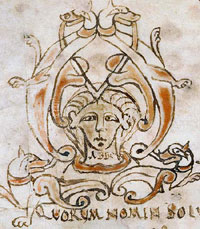
Abbo of Fleury |
|
985
|
In 985 a hoard of 163 silver coins was hidden at Gippeswic. This hoard was disovered in the Buttermarket, Ipswich, in 1863. It could well be that it was deposited in the face of another unrecorded Danish attack on Ipswich and the east coast.
In 985 Abbo of Fleury wrote his 'Life of St Edmund' at Ramsey Abbey, near St Ives. The significance of this event has caused some discussion amongst historians. Was this evidence that Ramsey had some form of oversight and control of the foundation of St Edmund's community at Beodricsworth, as has been suggested? If not, then why was St Edmund's story not written up at Bury?
The answer to this may simply be that Abbo was already well known as a very learned man in a wide variety of subjects, who was eager to become an hagiographer, or writer of saints' lives. He was the best man for the job, and the job was probably commissioned by a major patron of the abbey, such as Ealdorman Aethelwine, the most important Ealdorman in the whole country, who also lived nearby. The country was being raided by Danes on an annual basis, and it would help to improve morale if the story of St Edmund's own resistance to the Danes could be more widely known.
Abbo's book was based on a story told by Archbishop Dunstan as an example to his young monks. Dunstan said that he got the tale from the eye witness report of an old soldier who claimed to have fought for St Edmund. Some translations have described this witness as armour bearer of the King himself, but another reading of "sword bearer", is simply that he carried arms into battle. Abbo's "Life" was written 116 years after the events which it described. Nevertheless, this was to become the basis of all future lives of the saint, which were reworked many times in years to come.
The earliest texts of Abbo do not appear to mention any locations for the battle or for where the saint was laid to rest in a fine church. What he does imply is that the fine church, endowed with many gifts, was erected at the marker at which the saint was originally buried. Like Abbo, we know that the saints remains were by this time at Beodricsworth, now called Bury St Edmunds,
In other texts it is said that Abbo described Beodricsworth as as having been a villa regia, or kinges tun.
|
|
987
|
Some time within the years of 985 and 991, a monk, called Aelfric, wrote an Old English translation of the latin text of Abbo's 'Life of St Edmund'. Aelfric was working at Cerne Abbas, and as texts were passed around the network of monastic institutions, they were copied and re-copied. In his preface, he wrote that:
"Abbo recorded the entire story in a single book, and when the book came to us [i.e., Aelfric], we translated it into English, just as it stands now. The monk Abbo returned home to his monastery within two years, and was soon elevated to abbot of that same monastery. "
|
|
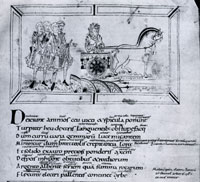
Tenth century manuscript |
|
990
|
According to a legend of the Abbey of St Edmund, recorded many years later in monastic records, around this time Ailwin was appointed guardian of the shrine. The secular priests who had been in charge of St Edmund's shrine for most of the century had been overtaken by new ideas of what was suitable devout religious practice. The rule of St Benedict was being adopted in the new monasteries, and it seems that they were widely held to be more devout and more fitting to guard a shrine. Perhaps the local people were not ready for such a drastic change at this time, and so Bishop Algare put Ailwin, described as a monk, in charge at Bury. It would seem that he merely ruled over the existing college.
The illustration is from the Psychomachia of Prudentius, a popular work copied in many religious institutions from the 10th to the 12th centuries. This page shows the desire for luxury, one of the 'Spritual Combats' that the devout monk had to undergo. This particular document was in the library at Bury Abbey in the 14th century. It is possible that it had been owned, and possibly even produced, by the secular college of monks in Bury around this time. The Bury College of monks may actually have been doing a good job already, before the Benedictines came here.
Dr Antonia Gransden has suggested that it is possible that St Oswald, the founder of Ramsey Abbey may have had a hand in introducing Benedictines to Bury. Oswald died in 992, so if this was the case it was well before the traditional date of about 1020 when Canute is said to have introduced them. Maybe Ailwin was a follower of St Benedict, but perhaps because East Anglia still had its own traditions, the King could not introduce Benedictine monks at this time.
|
|
991
|
By 990 a version of the Anglo Saxon Chronicle has survived from London. This recorded more news from East Anglia and it would seem that suddenly a second wave of Danish attacks assailed East Anglia. In reality it seems likely that raids had been going on here since 980, but had not been recorded in the Wessex Chronicles. In 991 a large, well organised army led by Olaf, later King of Norway, defeated the English at Sandwich, then attacked and ravaged Ipswich. Olaf Tryggvason of Norway seems to have masterminded this attack along with Svein Forkbeard of Denmark. This led finally to the famous Battle of Maldon, commemorated in an epic poem. Olaf had 93 ships and having over-run Ipswich defeated Ealdorman Byrhtnoth or Brihtnoth of Essex at Maldon. At this time Ealdorman Aethelwine was the chief man in East Anglia, but he was probably lying ill at home in Ramsey, as he would die in 992 of an affliction of the feet.
The poem records how a Danish representative stood on Northey Island and suggested that a battle could be avoided if tribute money were paid. Byrhtnoth replied from the mainland side of the causeway that the tribute would be paid in spears, deadly points and tried swords. The battle could not begin until the tide had ebbed sufficiently to allow the armies to meet. The poem records that the grey haired Byrhtnoth was hit by a spear, but continued to fight. Eventually his sword arm was disabled and he was hacked to death along with two loyal bodyguards.
By this time, Sturmer was the main centre in the Haverhill area, sending a famous battalion under their Saxon chief Leofsunu to fight at the Battle of Maldon which took place on August 11th 991.
During the battle when the English leader, Byrhtnoth, was killed, Godric, Godwine and others fled. The poem then records the last stand of the remaining army, quoting words of defiance from several loyal leaders. One such was Leofsunu of Sturmer in this dramatic translation by Bill Griffiths:
"Leofsunu spoke, raised his Linden shield
in defence, responded to his fellow fighter
I swear this. I will not step back
a foot's space. Rather I'll go further ahead
Avenge in battle my benefactor
No one round Sturmer, steady in judgement
will ever need accuse me, now my kind lord's fallen
of making for home, deserting my master
running from war. Better a weapon take me
Point or Blade. Then, in a passion
He fought fiercely. Flight he scorned."
Sturmer remained the chief settlement in the Haverhill area until about 1050.
To show that all classes of men were still willing to fight on, the poem gives more words of defiance to Dunnere, "a simple yeoman". Despite all this bravado, the English are defeated by the northmen.
Ealdorman Byrhtnoth's headless body was recovered to be finally buried at Ely, with a ball of wax to replace his head. Burying the body at the great monastery at Ely emphasises his importance as a symbol of resistance.
His widow was called Aellflaed, daughter of Aelfgar. She commissioned a hanging embroidered with the deeds of her husband. As her will (Sawyer reference S 1486) later recorded that there was a "holy foundation at Stoke (by Nayland), where my ancestors lie buried", it is quite likely that this tapestry was displayed there. No trace now remains of any monastery at Stoke by Nayland.
After these battles, the leadership of Essex and East Anglia was largely wiped out. It was left to the Archbishop of Canterbury, Sigeric, to lead an appeal to raise money to pay off the Danes. This was probably restricted to the areas mentioned, as so far there was no nationally organised way of mounting any response to the attacks. So, the invaders were paid a tribute, or "gafol" of £10,000 and a local peace was made. This was the first tribute payment that had been made for a generation. Later these tributes came to be called Danegeld. This money was raised by taxation, and only served to produce further raids and demands on other areas of England. Danegeld would seriously weaken the economy for years to come.
|
|
992
|
At Ramsey, Ealdorman Aethelwine died. He had been Ealdorman of East Anglia, but had not been at the Battle of Maldon. It is unclear who succeeded him as the major power in East Anglia. But by 1002 the organisation of East Anglian defence was in the hands of a man called Ulfcytel, who would come to be acknowledged as a great military leader.
The English ships were collected at London in order to head off further danish attacks. Aelfric, for unknown reasons, betrayed the King's plan to the Danes.
The Danes invaded again, not having total success despite betrayal of the King's intentions by Aelfric. However, the East Anglian ships were destroyed.
|
|
994
|
Olaf of Norway and and Swain of Denmark came to London to attack it on 8th September with 94 ships. The Danes suffered heavy looses and withdrew up the coast. They ravaged Essex, then obtained horses and attacked in Kent, Sussex and Hampshire. At Southampton they were given £16,000 to desist, together with food and supplies to see them through the winter.
During the truce, King Aethelred persuaded King Olaf of Norway to be baptised and his confirmation was sponsored by Aethelred himself. Olaf agreed to take his money and return to Norway, never to attack England again. This was a major coup for Aethelred, as it left Swein isolated.
|
|
996
|
The Abbot of Ely monastery at this time was called Byrhtnoth, the same name as the Ealdorman of Essex who died at Maldon in 991, but obviously a different person. He had ruled Ely since about 970, and was supposedly murdered by dowager Queen Aelfthryth between 996 and 999. The Book of Ely recorded (Liber Eliensis, book II s.29), that this Abbot bought some land at Toft, and the transaction was carried out in Cambridge. When the abbot asked for the customary sureties for the purchase, "everyone said in reply, that Cambridge, Norwich, Thetford and Ipswich were possessed of such great freedom and dignity that if anyone bought land there, he did not require sureties."
This confirms Thetford was one of the foremost towns in East Anglia by this time, with extensive rights and privileges. It had reached this stage by massive growth over the previous hundred years. By now its defensive ditch had been enlarged to up to 42 feet wide and 12 feet deep.
|
|
997
|
From 997 to 1014 viking raids occurred every year.
By this time Norwich was catching up with Thetford as the main city of the Norfolk area. It had better access to the sea than Thetford and could handle more trade more cheaply because of this advantage. However, an analysis of the coinage produced in those towns still gives Thetford the advantage. Analysed by the number of moneyers working in Aethelred's reign, at each place, Thetford is 6th in the country, while Norwich is tenth, and Ipswich is 18th.
|
|
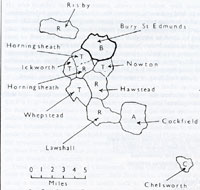
St Edmund's Endowments |
|
1000
|
In the years from 1000 to 1002, Aelfflaed, the sister of Aethelflaed of Damerham, drew up her will. She was probably the younger of the two sisters, and both women were daughters of Aelfgar, Ealderman of Essex around 946 to 951. Aelfflaed herself had been married to Byrhtnoth, also Ealdorman of Essex, from 956 until his death at the Battle of Maldon in 991.
The will of the Lady Aelfflaed still exists, and is catalogued as Sawyer S 1486. In this will, estates at Cockfield and Chelsworth are left to the monastery of St Edmund. Land at Nedging is left to her kinswoman Crawe in her lifetime, after which it will pass to St Edmund also.
The religious foundation of St Edmund at Bedericsworth had, by now, already built up a substantial endowment of valuable estates. Those nearest to the shrine are illustrated on this map by Cyril Hart, taken from his book, "The Danelaw".
Aelfflaed also left Waldingfield to Crawe for life, after which it would pass to the church of St Gregory in Sudbury.
|
|
1002
|
King Aethelred was faced with a constant series of attacks from the Northmen. He did not have an effective national army to fight back. He relied upon the local forces to mobilise to defend their local areas. In any case the Danes often moved very quickly, and there was little time to organise large scale defences. If he anticipated their movements he found that local forces would not trouble to defend areas outside their own sphere of influence.
In 1002 he married Queen Emma of Normandy to try to strengthen his foreign alliances. He built churches and promoted national lawcodes to promote good order and Godly behaviour. What else could he contemplate doing?
By 1002 a man called Ulfcytel was appearing in the witness lists of royal writs. These were drawn up in strict order of precedence, and Ulfcytel was listed among the Ministers. Although the later deeds of Ulfcytel make him famous, there appears to be no record of him before this date. Neither is there any indication of his ancestry or his kinships. The name is taken to be of Danish origin, and perhaps he was descended from the Danes under Guthrum who had settled around the Broads area after the Danelaw Treaty of 879. Or perhaps he was a native Dane, already well known in Scandinavia for prowess with arms, who was employed by King AEthelred as a mercenary leader to defend the English from the marauders.
In a desperate attempt to regain control of his destiny, King Ethelred ordered a general massacre of all the Danes in England on St Brice's day, November 13th. This was on a Saturday, the traditional bathing and rest day of the Danes. One victim turned out to be the sister of King Swein of Denmark.
Was Ulfcytel involved in this massacre? It is unclear exactly which "Danes" were to be attacked. Perhaps there were some guests at court, who were the "Danes" referred to. Did the king mean only newly arrived Danes or those old families who had been here since Guthrum's day?
Were the king's orders carried out in the Anglo-Danish lands of East Anglia? Presumably the new Danes were easily told from the old established Danish families who had been in East Anglia for over a century. In any case retribution would fall on East Anglia in 1004.
|
|
1003
|
In 1003, King Swein of Denmark invaded South West England seeking revenge for his sister. Exeter was destroyed by the Danish host. Aelfric led the levies from Wiltshire and Hampshire, but before the fight the Chronicles say that he pretended to be ill, and avoided the battle. The army was leaderless and Swein had an easy victory. The defeatism of Aelfric was to be contrasted with the fighting spirit of Ulfcytel in East Anglia by the Chroniclers. However, both leaders lost their battles.
|
|
1004
|
In 1004 King Swein or Sweyn sailed to East Anglia with his fleet of ships and men.
Making their way up the rivers, they attacked Norwich, sacked the city and then burned it down. Ulfcytel quickly took counsel with the East Anglian Witan to decide whether to buy peace with the Danes, or to fight. They decided that they had no time to gather the east anglian force or fyrde together, and agreed to pay off the Danes. As usual, they agreed a three week truce in order to give them time to raise the cash.
The Anglo-Saxon Chronicle tells us that under cover of the truce, the Danes marched inland to Thetford. Hearing of this, Ulfcytel sent a force to attack the Danish fleet, and destroy it at anchor. Something went wrong and the attackers failed in their duty.
Meanwhile, three weeks into the truce the force of King Sweyn Forkbeard reached Thetford and spent the night pillaging the town before they burnt it down.
Ulfcytel Snilling was apparently the local Anglo-Danish Ealderman, and by the next day he had raised a force to confront the invaders on Wretham Heath, north of Thetford, at Ringmere. However, he still did not have time to get the fyrde up to full strength. The Chronicle fails to name this fight, but later Danish sources give us the name of the battle site as Ringmere Heath.
Ringmere was a conspicuous location in the heathland of the area, having a round mere which fluctuated with the seasons. It was also the spot where five modern parish boundaries converge, and these were probably also boundaries of vills or settlements at the time. Such places were well known, and made good rallying points for the assembly of fighting men.
Nevertheless, the Chronicles tell us that the Danes had never met such stiff resistance before, and that if Ulfcytel had got more men, then he would have won.
Ulfketel or Ulfcytel took heavy casualties next day and lost the most senior of his East Anglian troops. However, although the invaders won the day, they too took heavy losses, and they ran for their ships and left the country. Ulfcytel had anticipated this and had sent orders to destroy these ships, but this never took place.
The writers of the Chronicles seem to have had a high regard for Ulfcytel, going out of their way to praise him. He was known as "snilling" in the skaldic verses sung about him in Scandinavia, translating as "the bold" or "the valiant". Charters of the time seem to refer to him as "Minister", rather than as Ealdorman. Some historians have interpreted this to emphasise that he was Ealdorman with some special status. But although he seems to carry out the duties of Ealdorman, he does not seem to have been given that title. He was killed in 1016, still fighting Danish incursions.
|
|
1005
|
In 1005 the Danes withdrew from England, probably because there was a famine in the land, and it was not worth staying. To give thanks, perhaps, for the Danish withdrawal, it might be seen as appropriate to give thanks to God via a gift to His church on earth.
Ulfcytel had rights over sufficient property that he could grant some of it to the Abbey of St Edmund. Sawyer document reference S 1219 records the grant of Rickinghall, Rougham, Woolpit, Hinderclay and Redgrave to St Edmund. This could also indicate that he was a Christian. Cyril Hart dates this Grant to c1005. It may be translated as follows:
"Here it is declared in this document that Ulfketel has granted to God and St Edmund the estate at Rickinghall and all that belongs to it, and the estate at Rougham and the estate at Woolpit and the estate at Hinderclay and that at Redfaresthorpe, as they stand with their produce and their men and with rights of jurisdiction, as he has owned them. If anyone alters this, God Almighty shall avert his countenance from him on the Day of Judgment, unless he has made amends for it here as quickly as possible."
According to Hart the Benefactors Lists of the Abbey also record gifts from Ulfcetel of Redgrave, Bradfield, Felsham and Hesset in the years 1005 to 1009.
These gifts were far from trivial. Rougham was probably one of the largest estates in Suffolk at the time. The Domesday Book would record it as having 5 carucates, 6 slaves, 93 freemen, and 27 men in Rushbrooke owed service there. In all it was worth £14 a year. Redgrave had 6 carucates, valued at £10 a year.
|
|
1006
|
In 1006 King Aethelred changed his advisers, trying to get new ideas to defend the country. It is possible that Ulfcytel of East Anglia was promoted to the Court at this time. In 1004 he had shown his determination to fight off the Danes.
The Danegeld finally paid to see off Sweyn and his host, was £36,000 of silver.
|
|
1008
|
As part of his strategy to placate God, who some thought had sent the Danes as a punishment, King Aethelred issued a new Law Code. This was drawn up by Archbishop Wulfstan of York. Throughout his career, Wulfstan tried to strengthen the position of the church. Part of this effort involved making explicit the rights of the church and the responsibilities of the English people to the church in the law codes. An element of preaching was also present in the law codes associated with Wulfstan. Problems within the church and the country at large can be detected from the content of these codes. Pagan practices were rejected by law which shows that some people had reverted to paganism after the Danish raids of the late tenth and early eleventh century. Clerical marriage remained a problem that was also addressed in the laws. In Æthelred's law code of 1008, the clergy were reminded of their responsibility to remain celibate, but also the reward of theign's status was offered to those who complied.
At the same time as passing his new law code, King Aethelred made the bold and innovative attempt to build a new fleet of ships from a national tax levy. He issued a levy on every Hide to raise the finance needed.
From 1008 onwards, for administrative purposes most of Haverhill was in the Risbridge Hundred of Suffolk, but one third of it in what is now the Hamlet Road area, was in the Hinckford Hundred of Essex. This split continued for almost nine hundred years, until the end of the nineteenth century, when the whole of Haverhill was moved into Suffolk in 1896.
|
|
1009
|
King Aethelred was unlike previous kings in that he did not marry off his daughters to foreign princes, or send them into a nunnery. He married them off instead to his Ealdormen in the areas outside Wessex that had been in the Danelaw, and may have held Danish sympathies. Thus in about 1009 it is thought that his daughter Wulfhild was married to Ulfcytel of East Anglia. Ulfcytel was, in effect, Ealdorman of East Anglia, but written sources refer to him as Minister, a somewhat lesser status.
It may be that his title of Minister may give a clue as to his origin. Perhaps he was not seen as quite English enough to be given the title of Ealdorman, but he was undoubtedly close to the King, and had a formidable fighting reputation.
By 1009 Aethelred had built most of his new fleet of ships, and they were assembled at Sandwich, ready to attack any Danish ships that came near the coast. The fleet was said to be larger than anything seen before.
However, there was discord between the commanders, and Wulfnoth of Sussex broke away with 20 ships and raided up and down the south coast. Another 80 ships were taken under Beorhtric's leadership to try to surround Wulfnoth. While at sea these were wrecked by a great storm. Wulfnoth apparently finished off the survivors. Any remaining ships retreated to London, and the great plan fizzled out into failure.
On the 1st August, King Swein attacked England again. Canterbury and East Kent paid him £3,000 to desist. He the sailed to the Isle of Wight, attacking it, then Sussex, Hampshire and Berkshire. They wintered on the Thames and "lived off Essex and the neighbouring Shires." They sailed up the Thames and attacked Oxford. The English could not seem to make any effective defence.
Men like Archbishop Wulfstan urged the king to see these disasters as a punishment from God for not being holy enough. From 26th to 28th September, the King called for three days of prayer and fasting. Every hide was instructed to pay one penny to the church. In 1009 the King also issued a new coin, known as the Agnus Dei issue. Aethelred's coinage had begun with a portrait of him in a toga. As the Danes came, his portrait was changed to show him wearing a military helmet. In 1009 he ordered his portrait to be removed altogether and replaced by a lamb, symbolising the lamb of god, and a dove to invoke the holy spirit on the reverse. This coin was only issued in 1009.
By the following year Swein and the Danish host were moving on East Anglia again.
|
|
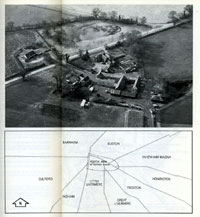
Rymer Point today |
|
1010
|
A large Danish force under Thurkill the Tall landed at Ipswich and sacked the town in the Spring, just after Easter. The force then moved towards Thetford. They marched to meet the Anglo-Saxon forces, led by the man who was effectively Ealdorman of East Anglia, Ulfcytel, at a place called Hringamere, (or Ringmere), on a date between 10th and 18th May, 1010. The battle was described as a 'bed of death', and despite help from Cambridgeshire, whose men alone stood firm, the East Anglians were defeated and fled. "It was Thurcytel 'Mares Head' that first started the flight", says the Peterborough Chronicle, (ASC version E). This location may well have been at Rymer Point, near Honington, about four miles south of Thetford. Rymer Point, near Honington, is illustrated here by an aerial photograph which shows only a relic of the mere that gave the place its name. This location is also extremely unusual in that nine parishes converge on the old mere, presumably to give watering, or fishing, rights to every parish in an area otherwise devoid of standing water. This would have been a well known place at which to call a rallying point for the fyrd.
Another possible location has been cited at Ringmere, four miles north-east of Thetford, but it seems more likely that an army that was intending to defend Thetford, would meet an attack from the Ipswich direction to the south of Thetford. This argument also supports an idea put forward by Alan Crosby, that part of Barnham Common was until recent times called Ringmere, and so this must also be considered a strong contender.
After the battle the Vikings got horses, and ravaged at will for three months, burning Thetford, and penetrating the Fens to burn Cambridge. In Essex, the village of Balsham was destroyed by the raiders. The village sign still commemorates the only survivor who hid in the church. Fighting also occurred at Nacton and Hadstock.
As the Peterborough Chronicle says: "
The Danes had possession of the place of slaughter, and then they were horsed and therafter had possession of East Anglia, and for 3 months raided and burned that country. They even travelled into the wild fens, and they killed men and cattle....and burned down Thetford and Cambridge."
As a symbol of a previous East Anglian resistance to Danish invaders, it was imperative to avoid the relics of St Edmund being defiled by the latest attackers.
So while the Danes were moving on Thetford, the remains of St Edmund were taken to London for safekeeping out of harm's way by a clerk of the community at Bedericsworth called Egelwin or Ailwin. London had already demonstrated that its stone walls could resist Danish attackers. In London the body was lodged at the church of St Gregory the Great.
Ther are some accounts reported by Yates in his 1805 book on Bury Abbey, that Turchill, one of the Danish leaders under Sweign, having harassed and devastated the whole of East Anglia, burnt and plundered Bury. This does not seem to be an unreasonable supposition, given that the Danes spent three months raiding and burning throughout East Anglia. Bury was, after all, only a few miles south of Rymer Point. Ailwin presumably got away before this happened.
Chaos now ensued throughout England. No shire would come to the aid of another, showing that the king could not arrange any coordinated defence.
The Danes now proceeded to the Thames Valley and into Oxfordshire in the heart of Wessex and back to Bedford burning as they went. Northampton was burned on 30th November. They returned to their ships with much plunder, and over-wintered in this country.
|
|
1011
|
The Danes attacked once again, led by Thurkill, or Torkyl, the Tall.
From September 8th to 19th, Canterbury was besieged and taken. The Archbishop Aelfheah was murdered by the Danes for refusing to pay a tribute.
A source from Scandinavia recorded a battle in 1011 at Newemouth, thought to be near Orford, in which the Danes suffered a defeat at the hands of Ulfcytel of East Anglia. Nevertheless, the tide of war was flowing in their direction.
The Chronicles listed all the shire counties where the Danes had effectively seized control by 1011. However, there are significantly neither Norfolk nor Suffolk so named, but instead, East Anglia. So the list begins;
"They had then overrun: (i) East Anglia, and (ii) Essex, and (iii) Middlesex,and (iv) Oxfordshire, and (v) Cambridgeshire, and (vi) Hertfordshire, and (vii) Buckinghamshire, and (viii) Bedfordshire, and (x) half Huntingdonshire, and to the south of the Thames all the Kentish and South Saxons, and the Hastings district, and Surrey, and Berkshire, and Hampshire, and much in Wiltshire."
Dr Lucy Marten has pointed out that this could be strong evidence that East Anglia had still not yet been divided into shires by the Kings of England, despite the fact that this arrangement was clearly well established everywhere else in the kingdom.
The Danish forces now left, only to return with Swein the next year.
|
|
1012
|
The dreaded Thurkill, or Torkyl, the Tall, now changed sides and brought 45 ships to England to join Aethelred in return for pay.
Despite the defeat at Ringmere, Ulfcytel kept his reputation. By 1012 he was at the head of the witness lists for Ministers attesting to writs and charters. He still does not appear to be an Ealdorman, despite the fact that he was the leader of the East Anglian forces in battle.
The "gafol" or Danegeld was £48,000, a massive sum, the biggest ever recorded.
From 1012 to 1051, another tax was levied to pay for a defensive fleet to be built and maintained against further attacks. This was known as the "heregild", and was levied annually, unlike the "gafols" or tributes which were paid periodically to buy off a Danish attack
|
|
1013
|
By now Aethelred had lost his grip and many people, particularly in the old Danelaw areas, were ready to see Swein take over. The Danish fleet arrived at Sandwich but quickly sailed north past East Anglia, into the River Humber and then up the River Trent to land at Gainsborough. Earl Uhtred and all of Northumbria immediately submitted to him, as did the people of Lindsey, followed by the people of the Five Boroughs. Thus when King Swein of Denmark landed he was soon accepted as King of Northumbria and all of eastern England north of Watling Street.
Swein had taken hostages from every borough under his control, and he now left them and his fleet in the hands of his son, Cnut. Cnut must have been only about 13 years old at this time.
Swein now provisioned his men, and taking horses, he marched south, and they" wrought the greatest evil that any raiding army could do." Oxford and Winchester submitted and Swein marched on London.
King Aethelred was holding London with the help of Torkyl the Tall, the Dane who was now working as a mercenary for Aethelred. London held out, so Swein marched west to Bath, where he received the submission of Ealdorman Aethelmar and his western thegns. Returning north, Swein found that he controlled nearly all of England. London now decided to submit "because they were afraid he would do for them."
Aethelred spent some time with his fleet on the Thames, while Queen Emma fled to the court of her Brother, Duke Richard II of Normandy. Aethelred then left the fleet to go to the Isle of Wight. After a season he decided that the situation was hopeless and joined Emma in Normandy.
By the end of the year, King Aethelred having fled to Normandy, Swein Forkbeard became King of all England. England was again under Danish rule.
|
|
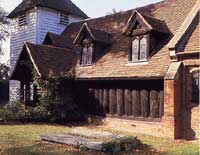 Greenstead Church
Greenstead Church |
|
blank |
By now it was judged safe to return the remains of St Edmund to the monastery at Bury. On the journey back, the body passed through Stapleford, and miraculously cured the local Lord. The manor of Stapleford was given to St Edmund in gratitude.
This journey was said to pass through Edmonton, Chipping Ongar, Greenstead, Chelmsford, Braintree, and Clare. An overnight stay took place at the wooden church at Greenstead, which remarkably survives today with many wooden features still in evidence. At the time it was probably entirely made of wood, as were most saxon buildings.
|
|
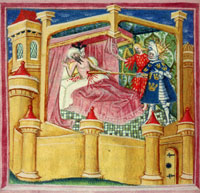
St Edmund 'impales' Swein |
|
1014
|
Following his great triumph King Swein Forkbeard had little time to savour his victory. On 2nd February he died suddenly at his headquarters at Gainsborough.
He was said to have been struck dead while threatening to sack St Edmund's town or extract a heavy ransom from it. It did not take long for the idea to circulate that he had been struck down by St Edmund himself. A life size picture of this event, showing St Edmund impaling Swein with a spear would be be painted over Edmund's shrine by Abbot Samson. The illustration here is taken from John Lidgate's "Life of St Edmund", produced in 1434.
The local people of Bedericsworth were said to have been so pleased to be spared Swein's extortions that they voluntarily agreed to pay a carucagium, or local land tax, to the monastery. The levy was four pence on every carucate of land. In later centuries no doubt this story was produced to answer local critics who questioned why this tax should be paid.
After Swein's demise, his son Cnut (or Canute) was chosen as his replacement by the Danish forces. Canute was only 13 or 14 at this point. Although the English had accepted Swein as king, they now advised that Aethelred should be sent for, but only if he "would govern them more justly than he did before."
Aethelred agreed to return, but only if the people "would resolutely and without treachery, turn to him." Thus it was agreed, and Aethelred returned in the Spring. An agreement was drawn up with the Witan that "every Danish king (be) outlawed forever."
Meanwhile Cnut had got the men of Lindsey to support him in an attack on the south. Before he was ready, Aethelred invaded Lindsey, forcing Cnut to take his ships and hostages and escape seawards, leaving the Lindsey men to suffer the consequences of supporting him.
The unfortunate hostages were put ashore at Sandwich after having their hands and noses cut off. Cnut escaped back to Denmark.
"And besides all these evils the king ordered the raiding army that lay at Greenwich to be paid 21 thousand pounds." It is unclear what this refers to, but it could be the mercenary payment to Torkyl the Tall for his 40 ships. Torkyl now leaves the scene, only to turn up again in 1016 back on the Danish side, in support of Cnut!
On 28th September, 1014, a natural disaster occurred when "that great sea flood came widely throughout this country, and ran further inland than it ever did before, and drowned many settlements, and a countless number of human beings." Low lying settlements in the Fens and the Broads areas were especially vulnerable, just as they still are today.
|
|
1015
|
At an assembly in Oxford, Ealdorman Eadric killed the two foremost thegns in the Seven Boroughs of the north. King Aethelred now seized their property and his son, the aetheling Edmund, rode to take possession of the north.
Meanwhile Cnut sailed via Sandwich, to the River Frome, raiding Dorset from Poole Harbour, Wiltshire and Somerset. Although Eadric gathered an army to support Aethelred, the king lay sick at Cosham. Eadric later took 40 of the king's ships, and submitted himself to Cnut. The West Saxons also submitted to Cnut, giving him hostages and horses, and Cnut stayed until mid-winter.
|
|
1016
|
Cnut continued his assault on England, with 160 ships, including those that joined him with Eadric. They went over the Thames into Mercia at Cricklade, and thence to Warwickshire, and "killed all they came to."
The king's son, Edmund, attempted to raise an army against Cnut, but there was a lack of enthusiasm without King Aethelred, who stayed in London. He had been ill since the previous year. Edmund now joined Ealdorman Uhtred of Northumbria, where, instead of attacking Cnut, they raided south into Staffordshire, Shrewsbury and Chester.
Cnut now struck northwards through Buckinghamshire, Bedfordshire and Huntingdonshire, to Stamford, Lincilnshire and up to Northumbria. Uhtred had to hurriedly return home, and he submitted to Cnut, but was subsequently killed. Cnut made Eric, son of Hakon the new Earl of Northumbria.
By Easter the Danes took ships south, while Edmund hurried to London to rejoin King Aethelred to defend London .
Before Cnut's ships had reached the Thames, the King died.
Ethelred the Unready died on the 23rd April, and the Chronicles commented, "after great toil and difficulties in his life". His son, Edmund Ironside, was proclaimed King in London, but Cnut was also crowned at Southampton. The country split into two camps. Thorkill the Tall and his army, joined on the side of Cnut. Ulfcytel the Valiant, Aeolderman of East Anglia joined on the side of Edmund.
By 9th May the Danes were laying siege to London, but Edmund had escaped to Wessex where he was received as king. Queen Emma, now the widow of Aethelred, was under Ulfcytel's protection in London. Edmund now demonstrated a determination to fight off the Danish invasions.
Now followed the Battle of Peselwood near Gillingham, where Edmund fought the Danes. After midsummer came another battle at Sherston, where the Danes came off worst, despite support from the English forces of Eadric and Aelfmaer Darling. The next battle came when Edmund travelled to London, and raised the siege, driving the Danes back to their ships. Two days later came another battle at Brentford. While Edmund regrouped in Wessex, the Danes attacked London again, but they abandoned that attack and went up the Orwell in their ships, ultimately to attack Mercia. Nothing is known about this campaign, but from the Orwell they could go inland via the Stour valley, or up towards Bury and Thetford. Scandinavian sources mention another battle of Ringmere fought by Earl Earik, and it is possible that this took place on this campaign.
They now attacked into Mercia, and returned with their ships, supplies, herds and other spoils to the Medway.
Then for the 4th time King Edmund assembled the whole English nation to cross the Thames at Brentford, on into Kent, and drove the Danes back to Sheppey. Ealdorman Eadric now changed sides again, and re-joined KIng Edmund.
The Danes again drove through Essex to Mercia. Edmund raised his army for the fifth time, and pursued them into Essex, to a hill called Assendun. This name has been translated as either Ash tree Hill or Ass's Hill, and its location is still the subject of debate.
After fierce fighting at Assendun in Essex, Cnut emerged as the victor. Ealdorman Eadric was blamed by the Chronicle as being the first to flee from the battle. Ulfcytel, Ealdorman or Minister of East Anglia was killed, along with "all the chief men in the English race."
This battle took place on October 18th, 1016. Ulfcytel Snilling was remembered at the Abbey of St Edmund, as he had given them lands at Rickinghall and Woolpit.
|
|
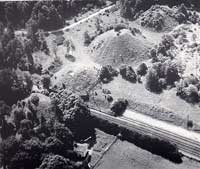
The Bartlow Hills |
|
blank |
There have been claims that the battle of Assendun took place at Ashdon, near Haverhill, but many historians have dismissed this location. They point to Ashingdon, also in Essex, but nearer Maldon, as the more likely site. In 1805 Yates believed the Ashdon story and cited the legend of the Bartlow Hills. These seven remarkable barrows were said to have been thrown up to hold the dead from the Battle between Edmund Ironside and Cnut. Today the Bartlow Hills are known to date from the Romano-British period, around the First Century AD, but only three barrows survive intact today.
Despite the red herring of the Bartlow Hills, there must remain some possibility that Assendun was located near Ashdon. In 1020, Cnut had a memorial minster built of stone and lime at the battlefield which is also unidentified, but locating this church would also locate the battle.
At Hadstock, close by Ashdon, stands St Botolph's church, which certainly dates back to this time. The main door, dated to about 1020, remains the oldest church door still in use in this country, while local legend includes a story involving a battle with the Danes. We should also recall that, at this time, Essex was not part of East Anglia. So if Canute wanted to attack this area he would come up the Icknield Way, through Essex, and past Hadstock. Similarly, Ulfcytel would stand and defend his East Anglian Earldom on its southern border at about this point.
Ulfcytel left the manors of Redgrave, Rougham, Rickinghall, Woolpit and six others to the monastery at St Edmund's. He may have left us the villages now called the Ilketshalls in East Suffolk, in which case, he probably had a home manor and powerbase at Bungay.He was called "snilling", meaning "the valiant", and East Anglia had by now become popularly known as Ulfcytel's Land in the Skaldic verses of the time. His origins are obscure as he does not seem to have had any relatives within the local aristocracy. Like Thurkill the Tall, he may have been a mercenary, brought over to provide an army to defend East Anglia in return for lands and position.
After the Battle of Assendun, King Cnut followed Edmund into Gloucestershire. Ealdorman Eadric and the councillors now tried to broker a peace between the two kings, and the kings agreed to meet at Ola's Island in the River Severn. It was agreed that King Edmund kept Wessex and the land south of the Thames, and the rest went to King Cnut. The Danish raiding army was paid off, and their ships went to London.
|
|
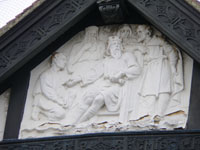
Canute at W H Smith's |
|
blank |
King Edmund Ironside died on 30th November, St Andrews Day, within a month of the Battle of Ashingdon, and so Cnut received all the kingdom. He was the first Danish King of all England, and was 23 years old. He was the famous King Canute, who was so upset by the constant praise of his court, that he is said to have demonstrated that he could not hold back the tides.
King Cnut or Canute, was descended from a long line of Danes who had caused great misery in England. One of his ancestors was Ivar the Boneless, who had killed St Edmund. He was the son of King Sweyn Forkbeard who had died suddenly (so it was said), after threatening to sack St Edmund's town. St Edmund must have hovered in the background of Cnut's mind as a saint not to be trifled with.
East Anglia, and indeed all England, was now once more under Danish rule and was to remain part of a large Scandinavian empire until 1042.
|
|
1017
|
Cnut was now officially accepted as King of all England. He had to find a form of government for his new kingdom which gave him overall control. He decided to divide it into four parts. He created four new earldoms of Wessex, East Anglia, Mercia and Northumbria. He kept Wessex for himself, and Thurkil the Tall was made Earl of East Anglia, for his part in the invasion. Mercia was given to Eadric, and Northumbria to Eric. The term of Ealdorman was now replaced by the term Earl for each of the four rulers of these regions.
Canute soon had Earl Eadric killed, along with several leaders of the old regime. He took firm control of the country.
When King Aethelred the Unready had died, he left a widow, Queen Emma. Emma and her children could have become the focus of any belated uprising, so Canute now ordered before the 1st August, that she "be fetched to him as wife."
Queen Emma was known in French as Emma, but in English as Aelfgifu. This was a common name in English aristocratic circles, so was clarified by the addition of her origins, thus she was called Aelfgifu of Normandy.
Emma was the daughter of Duke Richard of Normandy, and had already had three sons by Aethelred, the eldest of whom would later become Edward the Confessor.
Cnut too, was already married to Aelfgifu of Northampton, and she had two sons by him, one of whom was Harald Harefoot. Emma, however, seems to have made a pre-nuptial agreement with Cnut that only her sons could succeed to the English throne. By this agreement, Cnut perpetuated the eventually successful Norman claim to the English throne.
Since 1909 it has been the fashion for historians to assume that when Cnut married Emma, that he gave her West Suffolk as a wedding present. However there is another explanation of how she came into control of the eight and a half hundreds of Thingoe, which is explained in the entry for 1021.
Torkyl the Tall was now the Earl of East Anglia, probably the most important man in the country after Cnut. Scandinavian sources relate that it was Torkyl himself who had killed Ulfcytel of East Anglia at the Battle of Assenden. Torkyl now married Wulfhild, one of the daughters of King Aethelred, who was Ulfcytel's widow. Torkyl will remain a major figure in England until 1021.
|
|
1018
|
Cnut levied a tribute of £11,000 in London, and £72,000 from the rest of the country, using this to pay off part of his army, who returned to Denmark. Cnut sat at Oxford to draw up laws governing both Danishmen and Englishmen. Perhaps surprisingly, this was based on the already existing English law code of King Edgar, which was itself based around Christian teaching.
In 1018 Cnut also became King of Denmark, and overlord of Norway.
|
|
1019
|
Cnut spent the year and the winter in his new kingdom of Denmark, having taken nine ships with him.
|
|
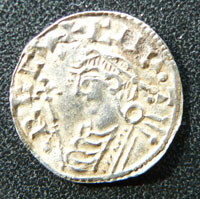
King Cnut or Canute
|
|
1020
|
Cnut built a church dedicated to St Edmund at the site of his victory at Assendun, in Essex, which was consecrated in 1020. Stigand was installed as the Priest in charge of this new foundation. The location of Assendun is still in doubt, but may have been at Ashdon in Essex. The round towered Bartlow church has been given this attribution in the past, and the church of St Botolph at Hadstock has also been considered a likely candidate. Whatever the location, this act of Cnut confirms an existing interest in St Edmund which was to help the development of St Edmund's shrine at Bury.
Canute was interested in religion and had already supported the cult of St Edmund. In 1020 he made a pilgrimage to the shrine at Bedericsworth.
Cnut was now consolidating his hold on the country. He had neutralised the old royal family by his marriage to Emma. He had killed off many of the old aristocracy who had opposed him. One possible issue was the cult of St Edmund. The saint had resisted previous Danish invasions by Cnut's own ancestors. There were whispers about the fate of his father Sweyn having been struck down by St Edmund. As an English martyr, Cnut needed to ensure that St Edmund did not become the focus of resistance to his rule. Having already dedicated a church in Essex to St Edmund, Cnut turned to St Edmund's shrine in Bedericsworth. He needed to embrace the saint as his own, by enriching his shrine, and gaining control over it.
At Bury, King Canute had to settle a dispute between the shrines' priests and the Bishop of Elmham whose diocese included Bedericsworth. The priests refused to pay over the normal tithes etc due to the Bishop, believing that St Edmund was exempt from such dues. Possibly in consultation with his new wife, Queen Emma, Canute tried to sort out the situation. Bury's own records state that Cnut, Emma, and Thorkill or Torkyl the Tall, now Earl of East Anglia, were all involved in this process.
In 1929 Lord Francis Hervey published some notes from MS 197 of Corpus Christi College, Oxford. This manuscript contained the Rule of St Benedict, and had been at Bury Abbey. At the back of the Rule at folio 105 is a note, translated by Hervey as follows:
"MXX (ie 1020 AD) In this year at length Bishop Aelfwine with Earl Thurkill's assent established the rule of the monks of St Edmund in the monastery; and with the goodwill and permission of King Cnut this continues to the present time."
|
|
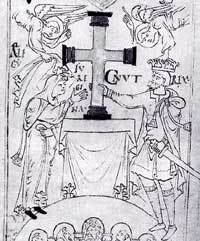
Cnut and Emma |
|
blank |
To appease the Bishop, the dozen secular priests, or clerks, at Bedericsworth were sacked, but the Bishop did not get control of the shrine. King Cnut arranged for the building of a rotunda to the church of St Mary at Bury. Bishop Ailfric of Elmham then granted the monastery freedom from episcopal control and replaced the secular priests guarding the shrine by 20 Benedictine monks, 13 from St Benet Hulme in the Broads near Norwich and 7 from Ely. The Benedictines were financially and spiritually independent of the Bishop. Uvius, the Prior of St Benet's, was made the first Abbot of St Edmundsbury.
The 12th century Liber Eliensis, or Book of Ely, reported this event as follows:
Book II, chapter 86 : "He (Bishop Aelfwine of Ely) also, by the decree of the King himself (Cnut), for the first time brought a contingent of monks to Bedericesworthe. He established there some monks from his own church of Ely, but others from Holm, and he supplied them with subsidies in abundance, with Earl Thorkell providing assistance, and, in addition, himself, for his own part, supplying the place with a collection of a great many goods and ornaments. He made a grant assigning it to eternal liberty and he appointed in authority over them as father and abbot, a humble, modest, pious man, named Uvi. As for the priests who used to live there without subjection to a rule: he either raised them up to the highest level of religious life in in that same monastery, or transferred them, provided with other possessions, into other monasteries."
M R James "On the Abbey of St Edmund at Bury" of 1895, referred to a document by John of Oxenedes that stated that the first books to be brought to Bury St Edmunds Abbey came from St Benet's Hulme with Uvius and the 12 monks from that place. However, it seems most likely that the church must have had some written texts already, if only for the conduct of prayers and bible readings. Other texts, like the Psychomachia of Prudentius, also seem to pre-date the coming of Benedictines to Bury.
The original 20 Benedictine monks included Uvius, Leofstan, (later abbot), Sparrowhawk, (Sparhavoc), Aethelwine, Alfweard, Leofden, Aelfric and Bondo.
The evicted secular priests numbered twelve, and Cnut gave them a privilege, or charter of their own. They were allowed to form a group known as the Duodeni, and given some recompense. They may have been allowed to keep some of the possessions of the monastery at that time, or they may have destroyed some documents in the confusion of the takeover. Certainly the Pinchbeck Register alleged later that the loss of some early charters of lands was due to this change-over of power. Abbot Baldwin would eventually make some provision for the surviving members of the group in his new church of St Denis.
Now, for the first time, Benedictines were installed within the old kingdom of East Anglia. As far back as the 970's King Edgar had wanted to put the rule of St Benedict into all the holy places in his kingdom. He had succeeded apart from in East Anglia. Cnut was now bringing this region into spiritual alignment with the rest of England.
In the Pinchbeck Register, which lists the gifts given to the shrine of St Edmund, all gifts made before 1020 are made to either "the clerks", or to the "community". After 1020 the gifts are recorded as being made to "the monks", a clear confirmation of the change to a Benedictine foundation.
With the coming to Bury of the Benedictines it is probable that the whole outlook of the monastery now changed. Whereas the old community of clerics probably had wives and some may have lived in the town, the new monks were under the strict written code of the Rule of St Benedict. The monastery now stood aside from the town, with the monastery enclosure being guarded by a gatekeeper. The brethren could not step outside the monastery without the permission of the abbot, could own no possessions without his agreement, and were sworn to reject carnal desires and to love chastity. Chapter 4 of the Rule laid down these rules, known as the Tools of Good Works. It ends with, "Now the workshop in which we make diligent use of all these tools is the enclosure of the monastery combined with stability in the community."
Chapter 66 of the Rule of St Benedict dealt with the duties of the gatekeeper who always had to be at hand to give visitors who knocked at the door a reply. This section also stated, "If it is possible, the monastery should be organised so that all its needs, that is to say, such things as water, a mill, a garden, and various crafts, may be met within its premises, so that the monks have no need to wander round outside it, for that does not profit their souls at all. This rule we wish to be read frequently in the community, so that none of the brethren may plead ignorance of it."
According to William of Malmesbury, King Canute also allowed the town of maybe a thousand people to be surrounded by a ditch and ramparts, becoming a burh or borough. However the town was of less significance than others in Suffolk. Ipswich already had a mint and had been a large trading centre for centuries. Thetford had been issuing coinage for years, and other towns important enough to have burgesses were Dunwich, Eye, Beccles, Clare and Sudbury.
Canute had given the town of St Edmunds a terrific leg up by his local reforms, and had endowed the new religious house with lavish gifts. If the name of the saint had now begun to define the town as well as the religious house, then it is likely that its new status as a burh would result in the name St Edmund's Burh now starting to be used over the next few years.
The exact organisation of local government at this time is extremely vague to us today. However, we need to remember that anglo-saxon England was a highly structured and organised society. Administration seems to have been very efficient by the standards of the time. We know that by 1097, the rents for burgage tenants, called hadgovel, had to be paid to the Reeve. This office later became called the Bailiff, and certainly by 1097, the Reeve was appointed by the abbot, and so the rents accrued to the abbey. So it is highly likely that a Town Reeve was appointed as part of the setting up of a burh.
The new burh dues payable to the town Reeve may have included Hadgovel, or the rent of one penny for each measure of land inside the town, probably for the right to occupy a burgage tenement or dwelling. This land could be inherited by its occupier's kin, but only on payment of a lump sum.
Coins issued by King Canute (1016-1035) were widely minted in places which included London, Lincoln, York, Stamford, Cambridge and Thetford. At Thetford, the moneyers included Aelfwig, Brunston and Telfwine, and the coins were short cross type silver pennies. At this time Bury was not a centre of coin production.
|
|
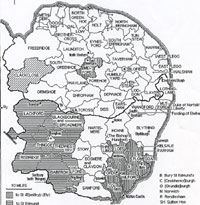
Norfolk and Suffolk |
|
1021
|
In 1021 Thorkell the Tall, the Earl of East Anglia, fell out of favour with King Cnut. We do not know the reason for this, but he was exiled, and returned to Denmark. The Earldom of East Anglia was now vacant, and Cnut could chose what to do about it. Rather than give this powerful area to another Earl, he chose to leave the post vacant and it would remain so until 1042. He now made radical new arrangements.
Peter Warner (The Origins of Suffolk, 1996), has argued that the county boundaries of Norfolk and Suffolk did not exist until the Norman Conquest. But Dr Lucy Marten suggested in 2006 that the Shiring of East Anglia actually took place in or around 1021, instituted by King Cnut. Cnut wanted to get a firmer grip on East Anglia, which had always been somewhat apart from the rest of England. Because of the region's trade, resources and strategic location, its Ealdormen had become of the highest importance in the land under the English kings, and Torkyll had been the foremost Earl in his turn. Such powerful men were always a potential threat to any monarch.
Shires had been set up in most of the country after 917, and a century later, East Anglia was still one unit. By breaking it up, Cnut could increase his own control over it. This would mean that Suffolk and Norfolk had their official birth at this time as units of administration.
Each shire was usually made by grouping together the existing Hundreds. A hundred was an area consisting of 100 hides of land for taxation purposes.
Each shire was normally put under the jurisdiction of a Shire Reeve, (later to evolve into the word Sheriff). However, the earliest records of Norfolk and Suffolk indicate that the two Counties were under the same Sheriff until Elizabethan times.
He was there to make sure local dues were paid to the King, and that the royal writ was obeyed locally. He was the King's representative in the Shire, a post which still survives today as the High Sheriff in each County. Technically it is to the Sheriff that the monarch sends a writ to institute the calling of a parliamentary election within that county in modern times.
Having decided to break up East Anglia, Cnut had to decide upon a boundary line. Thetford was the capital and was in the middle of the old Kingdom, and had long been an important powerbase in the region. Perhaps Thorkill had installed himself there, and grown too powerful. Cnut could weaken Thetford as a centre of potential resistance by putting his new shire boundary through the middle of it. By using the line of the Rivers Ouse and Waveney, Cnut not only cut East Anglia in half, but neutered the towns along their length. Thetford, Bungay and Eye were transformed from being centres of powerful hinterlands to being border towns divided between two administrations.
|
|
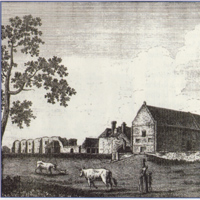
St George's in ruins 1779 |
|
blank |
As part of his pacification of Thetford, Cnut seems to have encouraged, or allowed, Uvius to found another new monastery at the site now known as the Nunnery at Nun's Bridges in Thetford. Uvius was now the new Benedictine abbot at Bedericesworth's shrine to St Edmund, appointed by Cnut in 1021, and the Thetford foundation was regarded as a possession of St Edmund's at Bury. Although this Thetford monastery is now known to us as St George's, its original foundation was said to commemorate the battle at which St Edmund died, pointing to Nunn's Bridges as the battle location. This is immediately adjacent to Barnham Cross Common, a site long held in Thetford lore to be the site of the battle.
If this monastery was originally dedicated to St George in 1021, then this would have been one of the earliest English traces of the cult of St George. St George was a soldier, and perhaps it was thought proper to commemorate a battle by a soldier saint, but it remains a question as to why it was not dedicated to St Edmund. Perhaps Cnut did not want there to be yet another reminder of Saxon resistance planted in Edmund's heartland. Or perhaps the dedication was changed, or added, later in the Norman period.
We cannot know whether this site at Thetford was truly believed to be the battle site at this time, or whether its choice was purely political in order to insert a Cnut-friendly foundation within the town. The origins of this monastery are more obscure than usual because by 1160 it had sunk into poverty and failure. It then became assigned to the Benedictine nuns of Lyng, in Norfolk, who lived there as the Priory of St George until dissolution in 1537. The attribution to St George is doubly curious, because the nuns from Lyng themselves had a chapel dedicated to St Edmund, and it would seem fitting that they should move to another site dedicated to St Edmund. Lyng is north west of Norwich, on the Fakenham road.
It seems possible that some pre-existing hundreds would have been dissected by Canute's radical new shire boundaries. This only mattered because of the distribution of the tax burdens which were associated with the hundreds. To avoid a complete re-drawing of the Hundreds, some fudges were made, examples being as follows. Diss Hundred was now found in Norfolk, but the town of Diss itself was put into the Hundred of Hartismere, which was now in Suffolk. Parts of Stoke by Nayland now lie in Essex, but were assessed into the Babergh Hundred of Suffolk.
In the absence of an Earl, Cnut could also dispose of the Earl's assets. He wanted to ensure that St Edmund's shrine did not become the focus of dissent. So the western part of his new Suffolk county was handed over to his Queen, Emma, to administer as if she were the Earl. Cnut could now keep a close eye on the shrine, while associating the royal family closely with it.
Queen Emma now held the Eight and a Half hundreds of West Suffolk, and set herself up in the 12 carucate Manor of Mildenhall, a large and prosperous estate. From here she controlled the patronage of St Edmund, and seems to have also been a patron of the whole of East Anglia. In practice she had all the privileges of the Earldom, as well as the specific control of the Eight and a Half Hundreds.
|
|
1022
|
Queen Emma now made herself comfortable by surrounding herself in East Anglia with men she trusted.
Stigand, the man in charge of the Assendun church of St Edmund, became her closest adviser over the years. By 1066 Stigand was the richest man in East Anglia, with 40% of his wealth coming from Norfolk and Suffolk holdings.
Queen Emma was also the patron of Ralph the Staller, Osgood Clapa, Eadric of Laxfield and Aelfric of Clare. Ralph may well have to come to England with her retinue when they left Normandy for her first marriage to King Ethelred. As Staller, he was one of Cnut's half dozen closest advisers. Aelfric of Clare was given the job of Steward or manager of her interests in the Eight and a Half Hundreds of West Suffolk. Aelfric owned Clare and Hundon which were two of the biggest manors recorded in the Domesday Book. He would build a tower on Clare Common, which may have been located at what we now call Erbury Camp. Aelfric would also give Long Melford to the Abbey of St Edmund, worth a handsome £20 a year, and he would found a College of Clerks at Clare.
Osgood gained lands at Pakenham. His nickname of Clapa seems to have meant a course or rough fellow. He was, perhaps, a bit more flamboyant than his fellows. In around 1095, Herman, a monk at Bury, described him as visiting the shrine with a gilded axe slung over his shoulder in the Danish manner. Herman must have been describing a scene from the 1040's.
Eadric of Laxfield may well have gone on to found Eye, and to set up Dunwich as a private port. Although Dunwich would experience explosive growth as a booming port over the next three centuries, there is no real evidence that it existed as an important place prior to the time of Eadric. The Roman centre in the area was at nearby Wenhaston, while the Anglo Saxon centre was at Blythburgh. Although it has been widely supposed that Dunwich had been the seat of Bishop Felix at Dommoc, established around 631, this would be very unlikely, given this scenario.
|
|
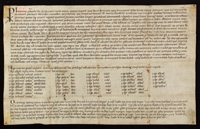
Canute's charter (S980) |
|
1023
|
There is a charter which was issued to St Edmunds Abbey by King Canute in the period between 1021 and 1023, which purports to give the Abbey a list of important privileges. This charter is in the Sawyer catalogue of Anglo- Saxon charters as reference S 980. Most authorities have considered that this document is spurious, and is therefore a forgery. However, Cyril Hart in "The Early Charters of Eastern England", 1966, believed that its content at least should not be lightly dismissed. His rough translation now follows below.
"The monastery at Bedericesworth shall always be inhabited by monks, and free from domination by the bishops of that shire; the monks are to elect their abbot freely, as granted by King Edmund. When censum danis is levied, either for ships or arms, the inhabitants of Bury are to pay their share to the monastery, for its own use. He grants the fish due to him annually by way of fine, and the fishery which Ulfketel had in Welle, and the profits of justice from all the vills belonging to the monastery, now or in the future. He confirms the queen's annual gift of 4,000 eels to the monastery, which was rendered to her from the villa called Lakenheath."
A fuller translation of the Old English text has been prepared by KIngs Lynn museum, who hold one of the main copies of this charter. It runs as follows, (with line breaks added for clarity):-
"TRANSLATION OF THE SAXON.
In the name of the Almighty Lord, I, Cnut, king, make known to all men concerning the counsel which I have taken with my counsellors, for my soul’s need and for the benefit of all my people, that is to say:—
That I grant eternal freedom to the holy king Saint Edmund in such wise henceforth as he had it heretofore in the place wherein he rests, and I will that this freedom stand in his dominion unchanged, from the power of every bishop of the shire whatsoever eternally free.
And so often as men pay army-money or ship-money let the township pay, according as other men do, to the behoof of the monks, who shall therein serve [God] in our behalf.
And we have chosen that no man shall ever convert the place to the use of men of another order, unless he would be cut off from the communion of God and all his saints.
And I grant to the monks for their nourishment all the fishery which Ulfkytel owned at Wylla, and my toll of fish -which arises to me along the sea coast.
And my queen AElfgyfu grants to the saints four thousand eels with their services which pertain to them, at Lakynge hythe.
And I grant to them jurisdiction over all their townships in all their land, which they now have, and may hereafter acquire by God’s grace."
|
|
1024
|
In 1023 or 1024, King Cnut and Torkyl the Tall were reconciled. Torkyl had been the Earl of East Anglia until 1021. Torkyl was put in charge of Denmark, so that Cnut could return to England. Cnut left his son by Emma, called Harthacanute, in Denmark under Torkyl's care. In turn, Torkyl's son Harold is taken by Cnut to live in the English court.
|
|
1026
|
Cnut had to defend Denmark against Swedish attack with heavy losses.
|
|
1027
|
Cnut visited the Pope and various shrines and was an enthusiastic Christian and patron of the arts, giving many splendid gifts to other religious houses, as well as to Bury.
Around this time King Cnut gave permission for the remains of St Botolph to be translated to the Abbey church at Bury. St Botolph had died in 680 and been buried at his church in Ikenhoe. In 970, King Edgar had given permission to move the remains, and they were taken to Burgh near Woodbridge. St Botolph's church still stands at Burgh. From Burgh they were now taken to Bury, and apparently some parts of the saint also went to Ely and Thorney.
At some point in the 11th century, the remains of St Jurmin were also removed to a new shrine at St Edmunds. They had lain at Blythburgh since 654. This is how this event was recorded in the 12th century Liber Eliensis, or the Book of Ely:
Book I, chapter 7 : "There is in the same province a place called Blythburgh in the vernacular, in which the body of the venerable King Anna is buried, and to this day is venerated by the pious devotion of faithful people. In that place, too (Blythburgh) his son Iurminus, (St Jurmin) God's chosen one, was buried, but afterwards he was translated to Bederichesworthe, which they now call Sanctus Edmundus, and given honourable burial."
|
|
1028
|
Cnut returned to Norway to secure his claim on it by expelling Olaf.
|
|
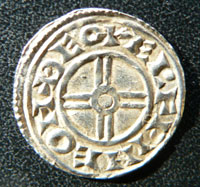
Elfwine of Thetford
|
|
1029
|
Thetford was an important town throughout the Viking periods. It had been a major Winter layover location for the invading Danish army in 869 and grew in strength since that time. It had been a minting centre for many years. The coin shown here was made by Elfwine of Thetford for King Cnut's government in the years between 1029 and 1036. It is only one example of many coins minted by many moneyers at Thetford in these times before the Norman Conquest.
After 1021 the amount of coins produced at Thetford seems to have declined somewhat. Large scale production moved to Norwich and Ipswich.
|
|
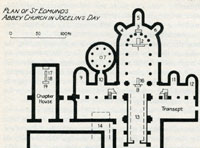
Location of the Rotunda |
|
1032
|
The new round church of stone, dedicated to St Edmund, was consecrated at Bury, situated to the north of where the Chancel of the Norman Abbey would later be built. When the new Abbey church was built in the 11th and 12th centuries, Canute's Rotunda was incorporated as the Rotunde Chapel of St Edmund. This diagram by Norman Scarfe shows how this may have been done. However, in 1032, this Round Church of stone stood alone, and would have been a wonder to the people of Bedericsworth.
Professor Eric Furnie has pointed out that there is no mention of a service of "translation", (relocation) of the saint's remains. From this omission he suggests that the new rotunda was built over the east end of the old wooden church. Part of the nave of the old church therefore probably survived to serve as a nave to the rotunda.
King Canute himself attended the consecration, having insisted that it be inaugurated on October, 18th, on the anniversary of his victory at the battle of Assendun. This battle had taken place in 1016 somewhere in Essex. The monks themselves would probably have hoped that the ceremony could take place on November 20th, St Edmunds Day, the anniversary of the Saint's martyrdom. This was Canute emphasising his attachment to St Edmund, but also making sure that it was understood that he was the chief power in the land now.
In 1929 Lord Francis Hervey published some notes from MS 197 of Corpus Christi College, Oxford. This manuscript contained the Rule of St Benedict, and had been at Bury Abbey. At the back of the Rule at folio 105 is a note which avoids this issue. It was translated by Hervey as follows:
"MXXXII (ie 1032 AD) In this year the basilica erected under King Cnut was consecrated by Archbishop Aethelnoth of blessed memory to the honour of Christ and Saint Mary and Saint Aedmund."
|
|
1035
|
King Cnut died and was buried at Winchester. Emma herself wanted her own son with Cnut, called Harthacnut, to inherit the crown. Indeed, she believed that she had an agreement with Cnut that her sons would inherit the crown. Unfortunately Harthacanute was in Norway, fighting Magnus, and when Cnut died unexpectedly he was too far away to to do anything.
Harold Harefoot seized the crown despite severe opposition from Earl Gowine of Wessex. Harold Harefoot was the son of Cnut and his first wife, Aelfgifu of Northampton in Mercia.
Queen Emma took up residence at Winchester, believing herself safest in the heart of Cnut's Wessex. However, the Chronicles say that Harold had taken away from her all the best treasures which King Cnut had.
Although viking influence lingered on, the Viking Age in England really died with Canute.
|
|
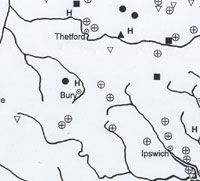
Viking Place names in Suffolk |
|
blank |
Suffolk's Viking place-names are limited to the following, according to Dr Andrew Rogerson of Norfolk Landscape Archaeology, writing in 1998. These are Ashby, Barnby, Eyke, Lound, and Risby. Norfolk has rather more, including Ormesby, Billockby, Felthorpe, Colkirk, and Topcroft, but there are others which mainly end in -by.
Dr Rogerson also pointed out that no Viking burials are known from Suffolk. In Norfolk, a double burial of a man and woman was excavated in 1867 at Santon in Lynford parish, associated with a pair of oval brooches and a sword; and a male burial with knives, spur, buckles, whetstone and ear-scoop was excavated by Rogerson in 1983 at Middle Harling. Despite this lack of evidence, Viking metal-detector finds from East Anglia easily outnumber those from other parts of the country. For example, Viking stirrup mounts are known from 109 sites in Norfolk and Suffolk, compared to 225 in the rest of England (see Late Saxon Stirrup-Strap Mounts, David Williams, CBA 1997). The curious absence of place name evidence contrasts with the ubiquity of small finds, and is a notable feature of the viking presence in Suffolk and Norfolk.
Streets like Colgate and Fishergate in Norwich probably took their names from the Danish 'gata', meaning street.
The Suffolk town of Beccles is particularly well endowed with 'gate' street names. These include Ballygate, Becclesgate, Blyburgate, Hungate, Ingate, Newgate, Northgate, Saltgate, Sheepgate and Smallgate.
However, outside these townships the Danes do not seem to have had a widespread impact on East Anglian place names. Only in the areas of Flegg, Blofield and Lothingland in the Broadlands area are there any number of the characteristic Viking names like Hemsby and Filby, with the 'by' ending. More places seem to end in 'thorpe', however. David Parsons has mapped the viking place names which he identified, and the Suffolk distribution may be seen in more detail by clicking on the attached thumbnail map. This map includes names which are classed as "Grimston hybrids". These names seem to combine a Norse personal name with the Old English "tun" or "ton", such as Thurston, Drinkstone, Somerton, Thurston End, and Grimstone End. Coney Weston may not refer to Coneys or rabbits, but to Kings Weston, and may have been a royal estate linked to Thetford if the word derived from the Old Norse word for king. However, the Old English word for King is quite similar to the Old Norse, making it difficult to be definite about the derivation. Similarly the hundredal name of Thingoe could derive from Old Norse or from Old English. On firmer ground, we know that the Old Norse word "toft" means a plot of land. The word "by" means a settlement, a name coined by speakers of Old Norse at the time. It indicates that norse speakers held land here, and may well have held it since before the 11th century. The name "by" also tends to be associated with marginal land or lower status locations, suggesting that such sites were taken up, not by a conquering army, but by later waves of peasant settlers. The "Ris" part of the name Risby seems to indicate wood or timber construction.
|
|
1036
|
Emma's son Alfred by King Aethelred went to visit her at Winchester. Earl Godwine not only stopped him, but had him imprisoned and his companions were killed. Alfred was then taken to Ely, and he was blinded on the journey. The monks at Ely could not save him, and he soon died of his wounds.
|
|
1037
|
Queen Emma was now a widow living in Winchester. She still had the Eight and a Half hundreds of west Suffolk , and her jewels. In 1037 she was evicted from Winchester in the cold mid-winter, and had to run away to Bruges in Flanders.
|
|
1040
|
King Harold Harefoot died and was succeeded by Harthacnut who was summoned from Bruges where he had joined his mother, Emma. He crossed the channel with 62 ships. To pay for the men and ships he levied a tax of 8 marks per rowlock. This outraged the chroniclers as King Harold and King Cnut were both said to have levied the tax for only 16 ships. Harthacanute thus asked for nearly four times as much.
Thus he was
condemned by the Anglo-Saxon Chroniclers for increasing taxes and "he never did anything kingly." He also had Harold's body thrown into a fen. His supporters were said to now turn against him.
Emma, however, was pleased to receive the "Encomium Emmae Reginae", a book of her life story. Emma's Encomium contains many interesting details of the politics of these times.
There is a Land Grant (Sawyer Reference S 1225, and Thomson ref 112), dated to around 1040, whereby one Thurkytel granted to the Abbey of St Edmund lands at Culford, (Culeforde), Wordwell, (Wridewelle), and Ixworth, (Gyxeword).
Interestingly the grant is to "God and St Mary and St Edmund", and not just to St Edmund. The dedication to St Mary was apparently a very old one at Bury. The original foundation there, before St Edmund, was said to have been dedicated to St Mary.
|
|
1041
|
Edward now returned to England to the court. He was Emma's son by Aethelred and had been in Normandy while the Danish kings were in charge. According to the Encomium, Harthacanute had invited him back to "hold the kingdom with him".
Harthacanute continued to cause resentment when he harried Worcestershire as revenge for the death of his tax collectors.
|
|
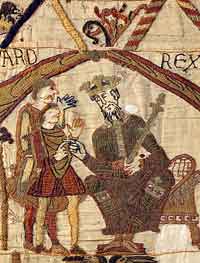
Edward the Confessor |
|
1042
|
Danish rule finally ended when Harthacnut collapsed and died "as he stood at his drink, and he suddenly fell to earth with an awful convulsion.... he spoke no word afterwards... and he passed away on the 8th June." He was succeeded by King Edward the Confessor.
Edward was an Anglo-Saxon, being Aethelred's son, but his mother was Emma of Normandy. For 25 years he had lived in Normandy, safely away from the reach of the Danish kings. Edward was also responsible for first bringing French ideas and Norman noblemen into English life. One such Norman was his Physician, Baldwin, eventually to become Abbot at Bury St Edmunds.
Edward never produced an heir and the problem of succession was to become acute in 1066.
|
|
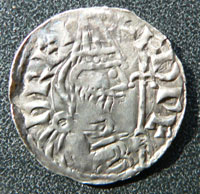
King Edward the Confessor
|
|
1043
|
Edward was crowned King on Easter Day, April, 3rd, 1043, at Winchester by Eadsige, the Archbishop of Canterbury. Stigand the priest was made Bishop of East Anglia, probably as a favour to his mother, Queen Emma.
However, this must all have been a ruse to get the coronation over with as smoothly as possible, for the Chronicles say that "quickly afterwards the King had brought into his hands all the lands which his mother owned, and took from her all she owned in gold and silver and untold things, because earlier she had kept it from him too firmly."
"And quickly after, Stigand was put out of his Bishopric and all that he owned was taken into the King's hands, because he was his mother's closest adviser and because she did just as he advised her - so men supposed."
The Bishopric of East Anglia was now given to Grymketal, who was brought in from Selsey.
The Worcester Chronicle gives us more details, saying that in mid-November the King took Earl Leofric, Earl Godwine and Earl Siward and their band, from Gloucester to Winchester to take Emma by surprise and to rob her of all the treasures which she owned. The reason given here is "because earlier she was very hard on the king her son, in that she did less for him than he wanted before he became king, and also afterwards." However, they let her stay there inside afterwards.
Thus did West Suffolk pass back from Queen Emma into the hands of the crown.
Since Canute divided up East Anglia in 1021, the area of West Suffolk had been administered as a unit by Queen Emma, the mother of Edward the Confessor. Edward the Confessor was Queen Emma's second son by King Ethelred. Emma had married Canute after Ethelred died and had other sons with Canute. Emma had supported Canute's son over Edward for the succession, and so when Edward came to the throne, he stripped his mother of her jewellery and her lands and income from West Suffolk.
It was first suggested that Emma owned West Suffolk since 1017, as part of her dowry from Cnut by Davis in 1909. If it had come to her as part of her dowry it is very doubtful whether the King could seize it back. Dower lands were part of the whole legal structure of the time, and they were held absolutely by the wife, whatever then happened to her husband.
|
|
1044
|
Some time during 1044, Abbot Uvius of Bury died, after 24 years service in that post. Leofstan, another of the original Benedictine monks of the abbey, was elected Abbot as his successor by the monks. Leofstan would rule the abbey until 1065.
When Leofstan took over, he found that the church contained ten books, consisting of 4 Gospels, one Missal, one book of Epistles, one Psalter, one gospel-book, one capitulary, and one Life of St Edmund. The Treasury contained 12 Cloaks, 9 copes, 7 stoles, 33 "costly robes", and many other items. Some of the monks had their own vestments, and occasionally a missal.
A further 30 books were recorded at the Abbot's country house, but these were noted as "not church books."
King Edward the Confessor now handed all of former Queen Emma's West Suffolk income over to the monastery at Bury under Abbot Leofstan, who was only the second Benedictine abbot there. There are 14th and 15th century manuscripts from St Edmund's abbey which attempt to explain why these awards were made. One story is that Edward the Confessor visited the abbey, walking the last mile on foot as a mark of piety. During his visit he supposedly saw the younger monks eating barley bread, because the abbey had insufficient income to be able to afford wheaten bread with every meal. "The saintly king then said that, therefore, he gives the blessed Edmund the manor of Mildenhall lest the boys of his relative St Edmund (for thus he calls St Edmund), should in future eat barley bread." The writ itself contains no indication that the award was made in order to feed the monks.
The Writ which the King issued to carry this out may be viewed in Old English, by clicking on its Sawyer Reference number here, which is S1069.
In modern English it includes the following clauses:
"Edward the King greets Bishop Grymketal and Aelfwine, and Aelfric and all my thanes in Suffolk friend-like; and I make known to you that I wish that land at Mildenhall and the nine less a half hundreds in sanctuary to Thinghoo belong unto St Edmund with soke and sack as full and as forth as it stood in my mother's hand...."
|
|

Edward's land grant to St Edmund |
|
blank |
The manor of Mildenhall had been Queen Emma's personal manor, from which she had administered the eight and a half hundreds of West Suffolk. It seems therefore, that the grant of Mildenhall was one of ownership, as compared to the grant of the hundreds, which was one of administration and overlordship. The manor of Mildenhall was extremely wealthy, and generated a good income and was to be a good source of food for the monks.
The area of other lands which this grant refers to is somewhat problematic because of the old English form of "nigen half hundreda". Monks who compiled lists of property after Domesday must have had some difficulty with this writ. They believed that they had jurisdiction over eight and a half hundreds, and so their summaries of old charters stated this fact. In 1805 Yates published one such summary with his own English translation, which can be read by clicking on this illustration. You can see that the monks interpreted "nigen half hundreda", as referring to the Half Hundred of Thingoe.
There is a recent article by Professor Richard Sharpe (Oxford) in which he discusses the Bury writs and gives his own translation and interpretation of them from the point of view of the charter diplomatic forms. He notes that the Old English is slightly confused and inconsistent in the grammatical treatment of the word 'socne' or 'soke' in all the various versions of this that still exist. His translation of this writ goes as follows:
"Edward king greets Bishop Grimketel and AElfwine and AElfric and all my thegns in Suffolk friendly. And I make it known to you that I will that the land at Mildenhall and the sokes of the eight and a half hundreds pertaining to Thingoe shall belong to St Edmund with sake and soke as fully and completely as it was in my mother's possession. And I forbid anyone to take away from them any of the things that I have already granted to them."
Here we see "nigen half hundreda" translated as "nine less a half hundred". This was a crucial issue for the abbey as this writ underpinned all of its other privileges.
The Kalendar of Abbot Samson was drawn up from 1186 to 1191, and listed all the hundredal rights which the King gave to St Edmund.
The land area concerned was usually later described as 8½ hundreds in size, and its shape was confirmed and fixed firmly when, with this gesture, the area became known as the Liberty of St Edmund and thus placed completely under the rule of the Abbot of the Abbey of St Edmund.
|
|
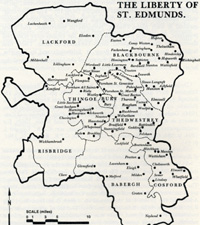
Map of the Liberty after Domesday |
|
blank |
The Eight and a Half Hundreds were as follows:
- Thingoe (with Sudbury)
- Thedwastre
- Lackford
- Risbridge
- Blackbourne
- Broadmere or Bradmere
- Babergh (valued at a double hundred, but excluding Sudbury)
- Cosford (valued at a half hundred)
The map shows the position some time after 1086, as in later times the Hundreds of Blackbourne and Broadmere were merged into the double hundred of Blackbourne. Bury itself was excluded from any hundred as it was exempt from the taxation system of the hundreds.
However, it is clear from the many attempts made to list out the Hundreds of the Liberty, that we cannot rely totally upon this list being the eight and a half hundreds as they were understood at the time. Boundaries and names have probably changed more than once since 1042, perhaps driven by the administrative needs and financial realities of the taxation systems imposed upon the Hundreds.
Abbot Samson's Kalendar includes implications that Sudbury was excluded from the double hundred of Babergh, and included in the valuation of Thingoe. It is suggested that this transfer was made to compensate Thingoe for the loss of the Banleuca of St Edmund when it was exempted from paying any geld. This could have been as far back as 945, when King Edmund gave the town to the shrine. On the other hand, Warner thought that Bury itself was valued at one and a half hundreds, in order to get his total up to eight and a half.
The meeting place of the soke was at the Thinghoe, a hill to the north of the town. Today we locate it in the area of Northgate Avenue. It is likely that a court or courts of law for the surrounding hundred were run from here, the town itself having its own burh court. The Liberty remained as an administrative unit until 1974. It was said that when Edward the Confessor visited the Abbey he always walked the last mile on foot as a pilgrim.
The old word hadgovel or hawgable dates from the Danish years, and supports the idea that the town had an administrative life at least as old as Cnut. Hadgovel was the Bury form of the word and represents the penny rent paid for each measure, or burgage plot, of town land. This rent persisted into medieval times and was often the cause of disputes with the abbey. It was payable only in the oldest parts of the town, which dated back to the old Anglo Saxon layout, around the area of the old market, what we now call St Mary's Square.
It is not clear what portion of local rents had previously flowed through to Emma, as part of her West Suffolk income, and therefore it equally unclear which local income streams were now diverted into the abbey of St Edmund. But at some point in time the hadgovel rents were assigned to the abbey and this is a point in time at which this could have happened.
|
|
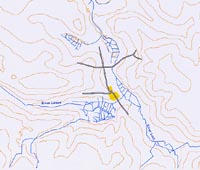
Bury in 1066 |
|
blank |
The High Street of Bury was probably parallel with the river in 1044, running more or less straight from Northgate Street to Southgate Street, without the dogleg shape only introduced into it by the expansion of the abbey after the Norman Conquest. The old market place was where Westgate Street joined these two streets. Raingate Street, Sparhawk Street and Maynewater Lane would thus have been part of this anglo-saxon area.
By contrast with West Suffolk, East Suffolk apparently had no such administrative unity until the formation of the two county councils in 1888. It contained the Liberty of St Etheldreda with only 5½ hundreds based around Sudbourne before its headquarters moved to Wickham Market, then Melton, then Woodbridge, where the Shire Hall still overlooks Woodbridge Market Hill. This liberty was an endowment by King Edgar to St Etheldreda (or St Audrey) to endow her monastery at Ely in 970.
As St Edmund's Liberty was to be outside the jurisdiction of the Shire Reeve, or Sheriff, a Steward was later to be appointed to represent the interests of the Crown within it, liasing with the Sheriff, but working to the Abbot. He had to ensure law and order within the Liberty. Such a function had been held by Aelfric of Clare for Queen Emma, and it seems likely that he carried on with these functions under the Abbot. Despite this, it is not clear when a Steward was first appointed by this name, but by the time of William the Conqueror, a man called Ralph was appointed and he also held the Manors of Lidgate and Blunham in Bedfordshire as his remuneration for the job. The Stewardship of the Liberty later became in the Abbots gift, and by 1120 it had become an hereditary position.
The Sheriff of Suffolk was left with the eleven hundreds remaining in East Suffolk over which he exercised the powers of taxation, and this area became called the Geldable, and its tax revenues went to the crown. Because geldable Suffolk was so small, Norfolk and Suffolk shared a Sheriff until the time of Elizabeth I.
|
|
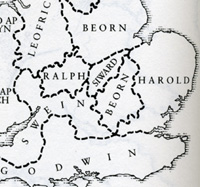
England after 1045 |
|
1045
|
It seems that by 1045 or late 1044 Stigand was reinstated as the Bishop of East Anglia, with his see at North Elmham in Norfolk.
The Earldom of East Anglia was given to Harold Godwinson, son of the powerful Godwin, Earl of Wessex. This took place when his sister, Edith, married King Edward the Confessor. Harold would eventually become King Harold.
|
|
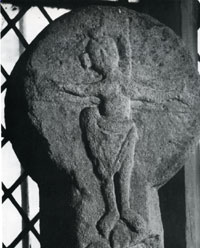
Kedington stone crucifix |
|
blank |
The first known document to use the names of Suffolk and Norfolk for the two counties dates to the period between 1043 and 1045. These references are in the will of Thurstan, great grandson of Brihtnoth, when he left lands in both shires to his wife, Aethelgyth. In his will Thurstan left Wetheringsett to the abbey at Ely. He also held Kedington and he left a life interest in that estate to his wife, Aethelgyth. After her death Kedington would revert to his two chaplains and the priest Aelwig. At around this time a stone crucifix was made which was erected at Kedington church. Later it was fixed to the east wall, below the gable, and in modern times it was brought inside the church.
It is tempting to believe that the names of the two counties must have been used much earlier in Anglo-Saxon times. This idea assumes that Suffolk people were the south folk of the East Anglian kingdom, separated from the north folk by the Waveney and Little Ouse rivers. South of the River Stour the East Saxons occupied today's Essex. However, there is good evidence to support the idea that these shires were set up in 1021 by King Canute, and that Norfolk and Suffolk were just convenient names to give the division of East Anglia into two parts. There does not seem to be any discernible difference between peoples north of the Waveney, and those to the south.
|
|
1046
|
In about 1095, Herman the monk recorded a story about Osgood Clapa to show how he was converted from a barbarian into a loyal follower of St Edmund. King Edward was in Bury with his court, and was discussing the Abbey's affairs with Abbot Leofstan. Osgood, who Herman described as a "major domus" was seen to enter St Edmund's church arrayed in barbaric splendour, with a gilded axe slung over his shoulder in the Danish manner. People thought his demeanour was insolent and offensive, and not appropriate in church. Osgood now suffered some sort of seizure in the presbytery. King Edward asked the Abbot to pray for Osgood's pardon and recovery. Osgood was carried to the shrine where he recovered. He now became a loyal votary of St Edmund, although he suffered a permanent weakness of his hands.
By 1046 Osgood Clapa had somehow offended the King and was outlawed and exiled to Flanders. Osgood had lands in East Anglia, including Pakenham, and had been a staller, one of the King's closest advisers. Some time between 1044 and 1047 King Edward the Confessor issued a writ which granted Osgood's Pakenham holdings to St Edmund, "as fully and completely as Osgood had it." This writ is in Sawyers catalogue of Anglo-Saxon charters as Reference S 1074.
It is possible that Eadric of Laxfield was outlawed at the same time, for there is a writ from King Edward dated some time between 1042 and 1065 which restored to Eadric all those lands which he had owned prior to his outlawry.
|
|
1047
|
The chronicles recorded that the winter was the most severe in living memory, with a mortality of men and cattle, and both birds and fish perished through the great cold and hunger.
Stigand, the Bishop of Elmham and East Anglia, was made Bishop of Winchester.
|
|
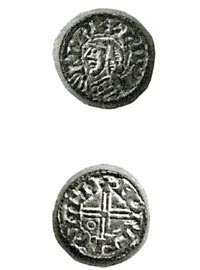
First coin minted at Bury |
|
1048
|
By 1048, Edward the Confessor must have granted the town of St Edmund its own mint, and its currency bears the first documented use of the name St Edmunds Bury.
The first coin types struck at Bury under King Edward are described as small flan, and only 3 examples are known. This series is dated by Seaby's as beginning in 1048, and running for two years. Five more patterns were struck at Bury from 1052 to 1065.
North states that the legend was EDMUND and the moneyer was Morcere. R J Eaglen quotes variations like ED, EDHUN, EDM, EADM, EADVM, and EAD.
The evidence of the coinage clearly exists, and presumably it must have been authorised by royal writ, but none survives. The first surviving writ granting the Abbey a mint comes in 1065, as part of the authorisation of Baldwin to take up the post of Abbot after the death of Abbot Leofstan.
The name Bury is derived from the word byrig or burh, meaning a fortified town. Therefore, by now, the town had built a ditch and ramparts on its borders where it was not protected by the River's Lark and Linnet and the Tayfen. Canute had given permission for such fortifications in 1020. The town wall itself would not be built for perhaps another hundred years.
Over the next century the rise of Bury St Edmunds would be mirrored by the decline of Thetford. With an increasingly powerful resident abbot, Bury would benefit from the market privileges, royal sponsorship and powerful donors which flowed to the abbey, while Thetford had no powerful resident lord to advance its position.
When Abbot Athelstan of Abingdon died, he was replaced by Sparhawk, or Sparrowhawk, a monk from Bury St Edmunds. This man may well have been the same Sparhavoc who was one of the original 20 Benedictine monks brought into Bury in 1020 from St Benets.
|
|
1049
|
The Pope asked Edward to help him attack Baldwin of Bruges, so he raised a fleet at Sandwich. At the same time Swein, son of Godwine, who had been sent to Bruges in disgrace also returned to England to try to get his lands back. Swein murdered his ally Beorn for some reason, but this caused most of his men to desert, and he fled back to Bruges.
While all this was taking place, the exiled Osgood Clapa returned to England with a fleet of ships and attacked Eadulf's Ness, (or the Naze), in Essex. He attacked the lands of the Bishop of London, an enemy of Earl Godwin.
|
|
1050
|
The Abbot of Abingdon, who had previously been the monk Sparrowhawk of Bury St Edmunds, succeeded to the Bishopric of London, but King Edward evicted him before he could be ordained. This seems to be because the Archbishop of Rome refused to accept him as Bishop of London, on orders from the Pope.
By about 1050 it is possible that Haverhill had an established market under its Saxon lord Clarenbold. It seems to have eclipsed Sturmer as the main centre in the area.
|
|
1051
|
In 1051 King Edward the Confessor issued a writ that gave all the lands held by the Abbey of St Edmund an exemption from the payment of heregeld, and all other renders. Heregeld was the tax levied to pay the 'here', or Danish army their Danegeld, but they were also exempted from taxes of all sorts by this charter. The writ also refers to Norfolk and Suffolk, rather than to East Anglia. This writ is referenced in the Sawyer list of Charters as number S 1075, and can be viewed by clicking on this reference.
The Normans claimed that William of Normandy was promised the succession to the English throne in 1051. William was supposed to have visited England to gain this promise from Edward. Other claimants were Harold Hardrada of Norway, and in England, Earl Godwine of Wessex had a claim.
In 1051, Earl Godwine of Wessex was exiled. Godwin had quarrelled with the king over the preferment the King was showing to foreigners, notably the Normans. The king also dismissed his wife, Edith, who was Godwin's daughter. She was also in disfavour because she had produced no children for the King. Godwin's son, Harold, (later to become King), went into exile with him, and his own Earldom of East Anglia was also forfeit, and handed to Aelfgar Leofricson.
|
|
1052
|
Opinion had turned against the King because of stories about the proposed Norman succession, and the Godwins were seen as preferable to the Normans.
Earl Godwin and his son Harold returned to England, and Harold once again became Earl of East Anglia, replacing Aelfgar. Some highly placed Normans now had to flee the country, including Archbishop Robert of Canterbury, and Ulf, Bishop of Dorchester. Stigand, the Bishop of Winchester, was now made Archbishop of Canterbury, supported by the Godwins, but opposed by the Pope.
|
|
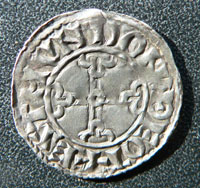
Minted at Thetford by Estmund
|
|
1053
|
Thetford continued to be an important town, and coinage made there remains plentiful today. This example was made by the Moneyer Estmund, and shows the reverse side of the coin shown above at 1044. From this pattern it is described by J North as coming between 1053 and 1066.
The inscription is fairly easy to see, particularly if you click on it to get an enlargement.
It reads ESTMVND ON DEOT, starting at bottom left.
DEOT or DEO is the abbreviation used at the time for Thetford.
ON means "of" or "from".
Many other inscriptions on coins made by hand are harder to see as they may be quite worn, or poorly struck in the first place.
Harold Godwine, Earl of Wessex, died and King Edward's position was strengthened at home. Godwin had had a claim to the throne. King Edward now invaded Scotland and replaced Macbeth by Malcolm, a more peaceful neighbour, and partly pacified the Welsh.
Upon the death of his father, Godwine, Harold Godwinson inherited the title of Earl of Wessex. He gave up the Earldom of East Anglia to Aelfgar once again. Harold Godwinson would virtually rule over large tracts of England throughout the rest of King Edward's reign.
|
|
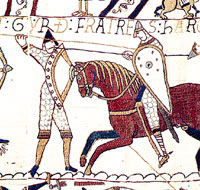
Gyrth at Battle of Hastings |
|
1057
|
Gyrd or Gyrth, a son of Earl Godwin, was made Earl of East Anglia, replacing Aelfgar. Gyrth would hold this title and die, fighting for his brother, King Harold, at the Battle of Hastings.
|
|
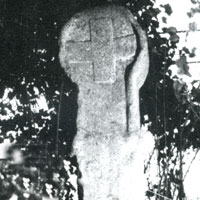
The Ashfield Cross |
|
1059
|
In the time of King Edward there were estates in and around Great Ashfield which were held by a man called Achi or Aki. This name seems to have Scandinavian origins. At Ashfield there is a damaged cross, standing 10 feet 6 inches tall, with a carved shaft, which seems to date back to this late Anglo Saxon period. This cross was being used as a footbridge to the churchyard, when it was recognised and rescued by Lord Chancellor Thurlow. He had it moved to his garden. The news of this cross was published in 1928 in Volume XX of the Proceedings of the Suffolk Institute of Archaeology.
|
1060
|
Abbot Leofstan of Bury built the church of St Benedict by the river at some period in his reign. However, the legend gives him a role in the miracle of St Edmund.
At some time around 1060, Abbot Leofstan decided to ensure the saints' body was still clean and not being neglected. The old monk Ailwin was called to verify the body, as he had taken charge of it back in 1010 when he took it to London. Leofstan decided to pull at the head to see if it was still miraculously attached to the body. Shortly afterwards Leofstan suffered a stroke, losing the use of his hands. The kings' physician, a French Benedictine called Baldwin was sent to give him medical aid. Apparently, once at Bury, Baldwin the physician stayed on, eventually to succeed Leofstan as Abbot in 1065.
|
|
|
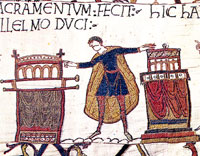
Harold swearing his oath |
|
1064
|
Earl Harold Godwinson, son of Godwine, visited William of Normandy. The Norman view is that this meeting was to confirm that both Harold and Edward supported William's claims, and this meeting features in the first section of the Bayeux Tapestry. The Chronicles do not mention such a visit.
The Bayeux Tapestry says that Harold swore an oath to support William's claim, but Duke William had made the oath more serious by tricking Harold into swearing on altars containing holy relics.
Why Harold should swear to support William when he must have intended to become King himself is unknown. If he took an oath, he may have intended to ignore it later. However, the fact that an oath was taken on holy relics made it the mortal sin of perjury to ignore it. This oath was to be a powerful issue in turning the Pope and many others against Harold's later coronation.
There were now three powerful claims to the English throne, all threatening the position of King Edward. They were Harold Godwinson himself, Harold Hardrada of Norway and Duke William of Normandy.
|
|
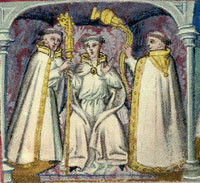
Baldwin installed as Abbot |
|
1065
|
At Bury, Abbot Leofstan died and Baldwin was appointed to the post of Abbot. Baldwin was a French monk from St Denis, outside Paris, from whence he became Prior of Leberau in Alsace. He had come to England at the persuasion of King Edward the Confessor to be his personal physician. Baldwin had been sent to St Edmund's by the King to treat Abbot Leofstan for his stroke in about 1060. Baldwin was so impressed by St Edmund's power that he had decided to stay in the monastery there. He was now only the third Abbot at Bury. The fact that such a learned and able Frenchman was given the Abbey at Bury at this time was to be of immense importance to the town in the aftermath of the Norman Conquest. He would be Abbot until 1097.
|
|
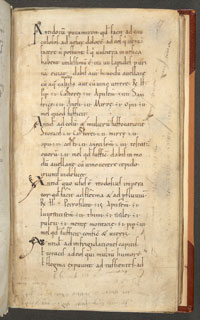
Abbot Baldwin's Medical Dictionary |
|
blank |
This early collection of medical recipes includes prayers to God, the Creator of man, and of ‘all the trees, plants and minerals’, for assistance with mixing and dispensing medicines. It also includes part of a Psalm and two musical treatises. Among the medical texts is the Antidotarum, or Book of Antidotes and a recipe for expelling ‘melancholia or phlegm and bile’. This document is Sloane MS 1961 in the British Library.
This book was originally brought from St Denis, near Paris to Bury St Edmunds abbey in Suffolk by Baldwin, a French monk who became abbot there in 1065 and was Edward the Confessor’s doctor. Bury became an important centre of medical study under Baldwin and several scribes added to this book during the 11th century to produce a reference collection perhaps later used in the infirmary.
King Edward issued his writ appointing Baldwin as Abbot, (S 1083), together with a writ confirming to the monastery the sokes of the eight and a half hundreds, (S 1084) and a further writ granting Abbot Baldwin the right to one moneyer in the town. This last writ is reference number S 1085 in Sawyer's catalogue of Anglo-Saxon charters and can be viewed by clicking on that reference.
From the coin evidence shown above, it is believed that a royal mint must have already existed in Bury since about 1048, and that this writ was merely to transfer the power into Abbot Baldwin's jurisdiction. This confirms Bury's importance as a trading centre before the conquest. At first it seems possible that the mint was located close to the Sacrist's office within the Abbey. In later years the mint was set up in Le Mustowe, or today's Mustow Street, and seems to have operated here, with a break, until during the 14th century.
|
|
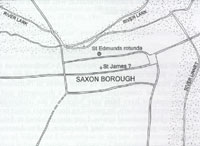
Bury by 1066 by Bernard Gauthiez |
|
blank |
Bernard Gauthiez has suggested that before the Norman town planning of Bury St Edmunds was carried out, the town had a reasonably regular layout during late Saxon times. This idea was published in 1998, in the volume entitled 'Bury St Edmunds Medieval Art, Architecture, Archaeology and Economy' edited by Antonia Gransden for the British Archaeological Association. Gauthiez laid out his reconstructions with east at the top of the plan to be consistent with the Warren map of 1776.
This hypothetical reconstruction is based around the area now called St Mary's Square, which can be made out to the right hand side, (south), of the plan. He suggested that a street extended from today's Raingate Street northwards to run along the western side of Canute's rotunda to join Eastgate Street. This street is now lost below the later abbey extensions.
Similarly, another street ran from Sparhawk Street and continued northwards to join up with Northgate Street, which may at some point have become called the High Street. Historians like Margaret Statham have previously suggested the existence of this road from the obvious alignment of today's Sparhawk Street and Northgate Street. This street was lost when the Abbey precinct was enlarged in the late 12th century, but there is now also considerable archaeological evidence for its existence. The earliest plans for the great new abbey church would respect this street line so that the abbey's west front would be built to end at this street line.
In addition, Gauthiez suggested that the line of Crown Street may also be a Saxon survivor, but that it probably veered westwards along Angel Lane and then along the western edge of Angel Hill.
|
|
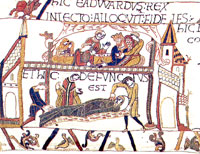
Death of Edward the Confessor |
|
1066
|
King Edward the Confessor died on 5th January 1066, and the Chronicles say that he committed the kingdom to Harold Godwinson. The Witan had gathered to Westminster for the Christmas crown wearing ceremony, and so were on hand to deal with the succession. They offered the crown to Harold. Harold took power immediately and both in Norway and Normandy preparations were made to invade England.
Harold was crowned on 6th January in Westminster Abbey, just one day after Edward's death. Hostilities began in April with raids in the south. Soon after, Hardrada and Tostig (Harolds' exiled brother) invaded in the North from Norway. They took York on 20th September but Harold killed them both at the battle of Stamford Bridge, four days later. Hardrada's fleet of 300 ships was destroyed, and only 24 escaped. The Norwegian invasion was defeated, but the exhausted army now had to march south to face a second force.
|
|
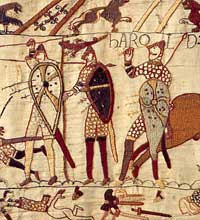
Death of King Harold |
|
blank |
On 27th September, the long feared attack of Williams' fleet was launched from the Somme estuary. They landed 7,000 men unopposed at Pevensey but moved to a new base at Hastings. Harold was still in York and it was not until 14th October that he could get the army down to Hastings. The fighting ended when Harold was killed, possibly by an arrow in the eye. William ravaged much of southern England, took Canterbury and Winchester and moved towards London.
On 25th December 1066, William the Conqueror was crowned King of England and Anglo-Saxon England was no more. The Norman Conquest had taken place, and would be followed by a great takeover of Saxon property.
The events of 1066 are repeated in more detail in the next section of this Chronicle.
|
|
Quick links on this page
Top of Page 865
Death of King Edmund 869
Partition- England/Danelaw 878
Saint moved to Bed'sworth 906
Mercia broken into Shires 920
Bury given to the monks 945
Abbo's Life of St Edmund 985
Battle of Maldon 991
Danes cause saint's move 1010
King Canute takes over 1016
Benedictines come to Bury 1020
Round stone church built 1032
W Suffolk given to Abbey 1044
Baldwin comes to Bury 1060
|
After the Conquest
Please click here to follow these Chronicles into 1066 and the reign of William the Conqueror.
Prepared for the St Edmundsbury Local History Project
by David Addy, June 1998 - June 2001, last revised on the date shown below
Reference Books and online resources
Michael Swanton (trans) The Anglo-Saxon Chronicle PB 1997
Ann Savage (trans) The Anglo-Saxon Chronicles
Peter Bishop - The Sacred and Profane History of Bury St Edmunds
David Dymond and Peter Northeast - A History of Suffolk.
M D Lobel - The Borough of Bury St Edmund's
R Yates - An illustration of the Monastic History and Antiquities of the Town and Abbey of St Edmund's Bury, (1805)
Robert S Gottfried - Bury St Edmunds and the Urban Crisis 1290 - 1539 (1982)
C R Hart - The Early Charters of Eastern England, 1966
Cyril Hart - The Danelaw, 1992
Jeffrey North - English Hammered Coinage, Volume 1, 1994
Bill Griffiths (Translator) - The Battle of Maldon
Archives of the Abbey of Bury St Edmunds - by Rodney M Thompson, Suffolk Records Society, 1980
The Golden Age of Anglo Saxon Art by Backhouse et al for the Trustees of the British Museum
'Bury St Edmunds Medieval Art, Architecture, Archaeology and Economy' edited by Antonia Gransden for the British Archaeological Association, 1998
www.trin.cam.ac.uk/chartwww/NewRegReg.html.OR Anglo-Saxons.net for Anglo Saxon Charters
Lucy Marten
The shiring of East Anglia: an alternative hypothesis
Historical Research (OnlineEarly Articles). 2006
Robin J Eaglen - The Abbey and Mint of Bury St Edmunds to 1279, 2006.
Paul Blinkhorn et al - The Ipswich ware Project, 2012
www.spoilheap.co.uk - for Ipswich ware etc
|




















































